TORONTO - How many Torontonians does it take to cross the street?
One pedestrian and, soon, one city employee to tell you how to do it better.
City officials are spending around $100,000 to investigate a “Transportation Assistance Personnel” (TAP) in the downtown core as part of the fight against congestion.
“We’re actually going to have people in the intersection moving pedestrians who dawdle and you know those people who start crossing the street when it turns to amber,” public works chairman Denzil Minnan-Wong told the deputy mayor’s roundtable on gridlock and traffic congestion Friday.
Councillors approved the move last December when they voted on the final report of the Downtown Transportation Operations Study.
The study contained several projects to fight congestion including TAP arguing that it would “improve intersection operation by assisting and providing guidance on traffic operations.
“TAP could be deployed to reduce the frequency of intersection blockage,” the staff report read.
That study will include establishing a final price tag for the program.
Miles Currie, the director of the city’s traffic management centre, said the workers would be rotated from intersection to intersection.
“They could be marked like a crossing guard or something fluorescent,” Currie said.
“They won’t have any legal authority to issue tickets or summons of that nature but more to remind motorists not to block the crosswalk, remind pedestrians not to cross against the signal, to remind them to just be thoughtful of the time they have before they cross the street.
“We also see them keeping on eye on illegal stopping and parking.”
Currie said ultimately the city wants to have two-way communication with the TAP and the city’s traffic centre to report delinquent parking behaviour.
Similar programs already exist in Chicago and New York City, he said.
“The idea is (to be out there) out of courtesy,” he said. “They may have some flyers to give pedestrians, cyclists and motorists just to remind them of the impact of some of their behaviour.”
Bureaucrats are doing “some more homework” on the project but it is expected to go ahead.
“Our goal is to implement this project,” Currie said.
Please share this
Toronto's News, Free Daily News from the Toronto Star, Globe and Mail, Toronto Sun, National Post, CP24, CTV, Global, 640toronto, CFRB, 680 News
Friday, February 28, 2014
Thursday, February 27, 2014
That time when the TTC went to Niagara Falls
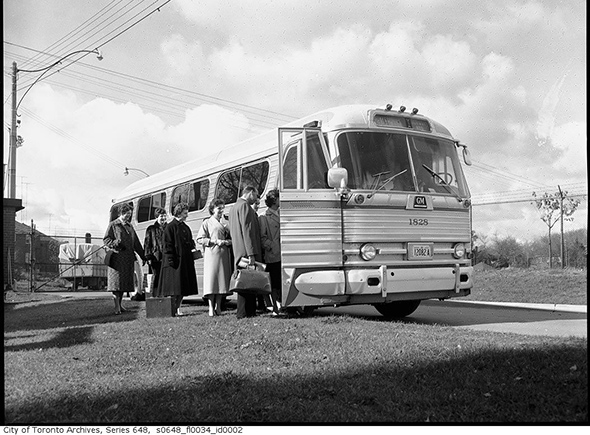 Strolling through the art deco-styled Toronto Coach Terminal today, one notices a cathedral window
that sits atop a flight of stairs overlooking the main waiting area.
Lighting up with the late afternoon sun, it bears the name Gray Coach
Lines, a reference to the bus operator that originally called the
terminal home back in 1931. Now you're more likely to see a Greyhound
than a Gray Coach at Bay and Edward streets, but for 64 years the latter
was a common sight on Toronto roads and Ontario highways.
Strolling through the art deco-styled Toronto Coach Terminal today, one notices a cathedral window
that sits atop a flight of stairs overlooking the main waiting area.
Lighting up with the late afternoon sun, it bears the name Gray Coach
Lines, a reference to the bus operator that originally called the
terminal home back in 1931. Now you're more likely to see a Greyhound
than a Gray Coach at Bay and Edward streets, but for 64 years the latter
was a common sight on Toronto roads and Ontario highways.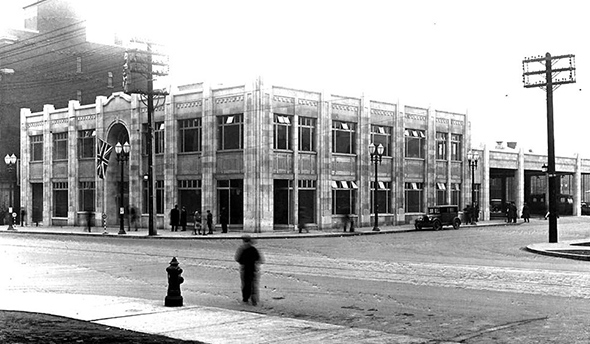
Gray Coach Lines was founded by the Toronto Transportation Commission in 1927 as a sightseeing tour operator and suburban commuter service meant to replace the old radial railways that serviced places like Mimico, Richmond Hill, and Schomberg. Over the following decade, the TTC snapped up competing operators across the province, which ushered in a vastly expanded reach for Gray Coach. By the mid 1930s, the bus operator provided service to places like Barrie, Guelph, Hamilton, Buffalo, and, of course, Niagara Falls, a route that was particularly popular given its tourist status.
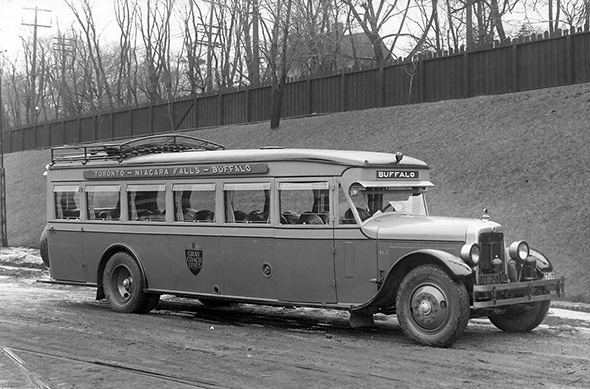
When the TTC built the Toronto Motor Coach Terminal in the early 1930s, it was in response to the growing popularity of bus travel, which was booming at the time. A whole world of inexpensive travel was opened up by the motor coach, and people ate it up. Car ownership was yet to become widespread, and the bus offered a measure of freedom that was in high demand.
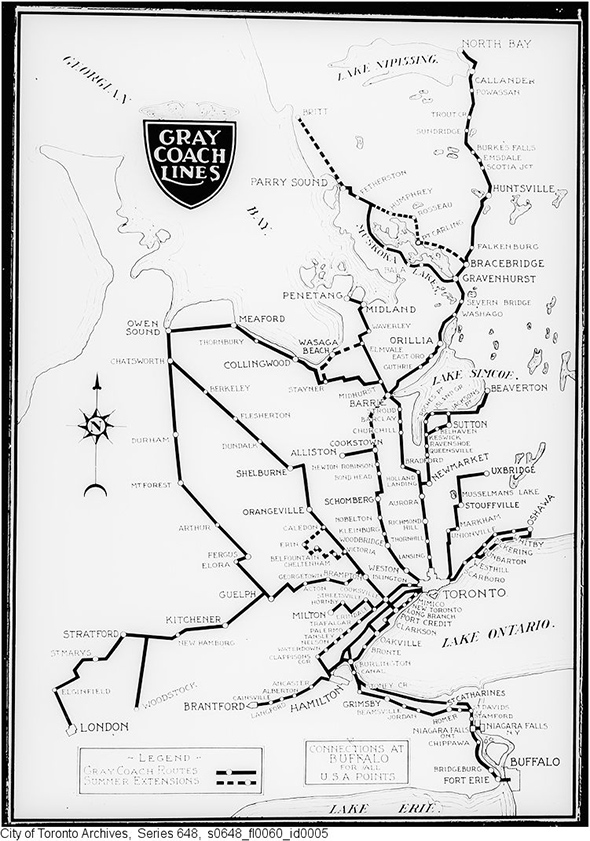
By the 1950s, the range of destinations reached by Gray Coach covered most of Southern Ontario and extended as far north as Sudbury. While the bus has always been a lower class of travel to the train and the car, this was something of a golden age for these vehicles, where the greater number of towns and cities serviced by the motor coach mirrored the post-war fantasy of ever increased mobility (it's no coincidence that motels undergo a building boom during this period as well).
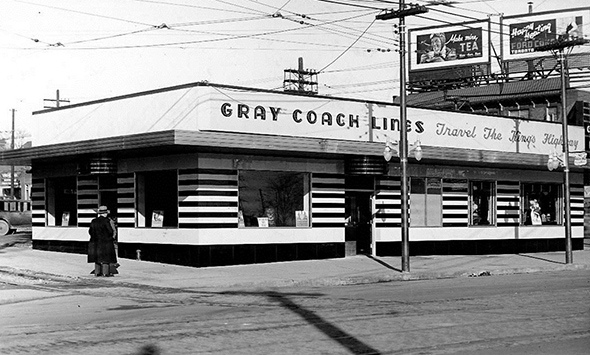
The spirit of Gray Coach Lines is perhaps best captured in a photo of its Sunnyside bus terminal in the 1950s. Perched at the edge of the city, the striped building brims with the promise of exploration and travel. "Travel the King's Highway," an accompanying slogan reads, marking the degree to which the bus was deemed a dignified way to travel. That would eventually fade with a dramatic rise in the popularity of commercial air travel in the 1960s and '70s, but there's a lingering romance to coach travel even as it's deemed an inferior mode of transportation. Air travel is destination-driven, while the bus offers the double promise of escape and exploration captured in the figure of the road.
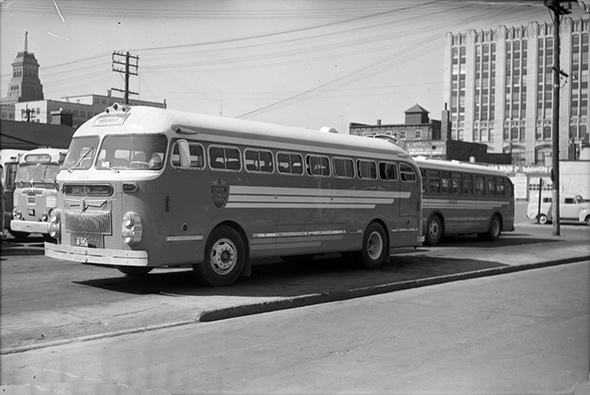
By the time GO Transit was founded in the early 1970s, Gray Coach was contracted to operate some of the routes it already serviced, but despite the strength of the operation at the time, the ability of the TTC to run the company would eventually come under pressure from competitors like Greyhound and Trentway-Wagar. By 1990 the decision was made to sell Gray Coach Lines in order to focus exclusively on urban transit. The company was eventually acquired by Greyhound and Ontario Northland in the early '90s, leaving behind our coach terminal as a legacy of its former domination of inter-city bus travel in Southern Ontario.
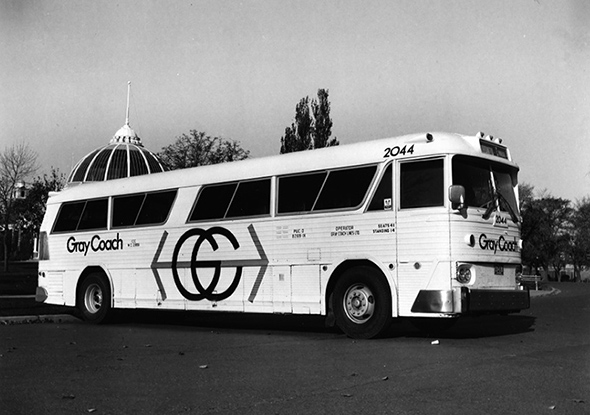
Photos from the Toronto Archives and York University
5 firsts that changed Toronto forever
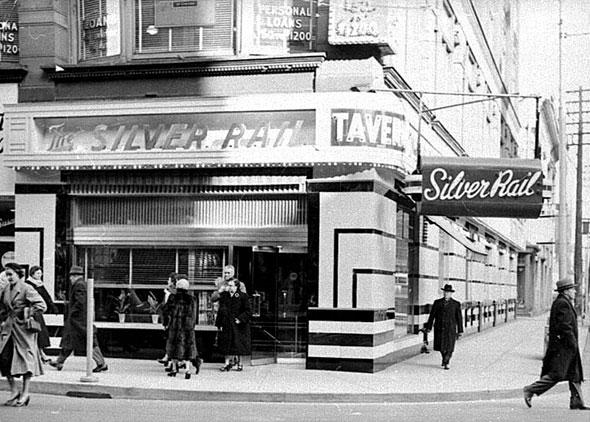
It's hard to imagine a time when it was impossible to legally order a cocktail, get a cup of Tim Hortons coffee, or go home to an apartment in Toronto but, of course, the city didn't always have those things, and there had to be a first for everything.
Broadly speaking, Toronto began to develop the things we now recognize as ubiquitous - shopping malls, apartment buildings, chain restaurants - in the 20th century, sometimes decades behind other major North American cities. Alcoholic drinks that weren't beer or wine took a particularly long time to reappear after prohibition due to tight license restrictions.
Here are the stories of 5 major Toronto firsts.
THE FIRST TIM HORTONS
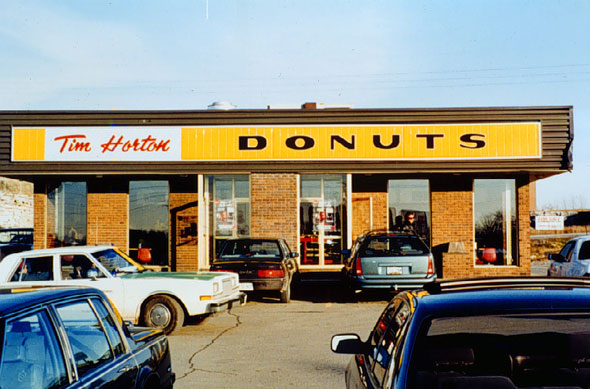
If there's one thing Toronto, or any Ontario community for that matter, has in spades, its Tim Hortons outlets. The first Toronto store of the ubiquitous chain opened at 853 The Queensway in Etobicoke (a previous incarnation of the company, a chain of drive-in steak restaurants, ran a short-lived "Tim Horton Do-Nut" in a Lawrence Ave. shopping plaza in the 1960s) and looked much like the store pictured above.
Former Toronto Maple Leaf strongman Horton founded the company we recognize today out of a former Esso station at Ottawa St. and Dunsmure Rd. in Hamilton with the help of business partner Ron Joyce in the late 60s. The Queensway store arrived on the 1st June, 1970, and it's still there - albeit substantially renovated.
THE FIRST SHOPPING MALL
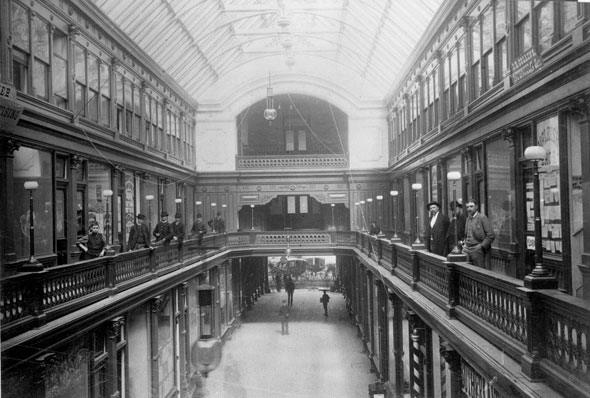
Built in 1883, Yonge Street's Toronto Arcade was by just a few years the first building in Toronto to enclose multiple stores within a single, multi-level building.
A two-storey atrium, skirted by ornate woodwork and lit by a massive 130-foot glass skylight, provided storefront space for 52 retailers, including the Arcade Saloon and Restaurant, Arcade Cigar Store, Alexander Chinn's Barber, James Pape's florist, and Miss Westmacott's School of Design and Drawing for Ladies.
The third and fourth floors were leased as apartment and office space. The British American Business College, which taught book-keeping, manufacturing, correspondence, penmanship, shorthand, mental arithmetic, and, oddly, "steamboating," occupied the first level above the shopping concourse for many years and advertised on its exterior.
The Toronto Arcade fell into dereliction in the 1950s following a series of fires and many inglorious years as a discount mall, and was knocked down. The Arcade Building with its neon rainbow exterior opposite Temperance Street was built on the site in the 1960s.
THE FIRST APARTMENTS
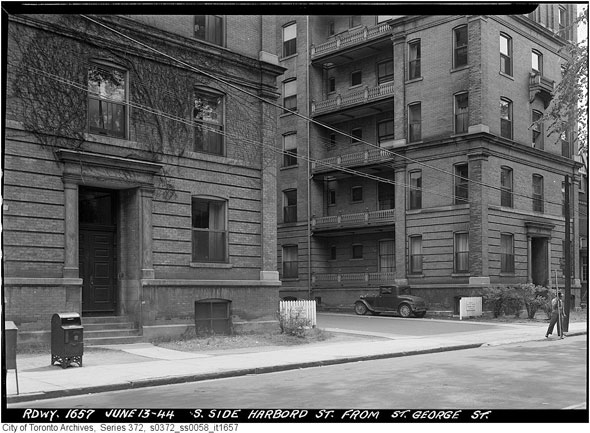
Toronto was extremely slow to issue the permit for its first purpose-built apartment complex. Cities like New York, Detroit, Cleveland, and Buffalo had already seen demand for mutiple-occupancy buildings when, in 1899, the Improved Realty Co. of Toronto Ltd. started work on the St. George Mansions at Harbord, Hoskins, and St. George streets.
The six-storey, C-shaped pressed brick and Bedford stone building contained 34 apartments and was home to 99 people in 1904, many of them wealthy middle-aged married couples. It was soon joined by similar buildings on University Avenue, Huron Street, and Spadina Road.
It was demolished in the years after the second world war, during which it was repurposed as the Toronto home of the Canadian Women's Army Corps and nicknamed "cockroach palace." It was replaced by the University of Toronto's Ramsay Wright Zoological Laboratories building in 1965.
THE FIRST COCKTAIL LOUNGE
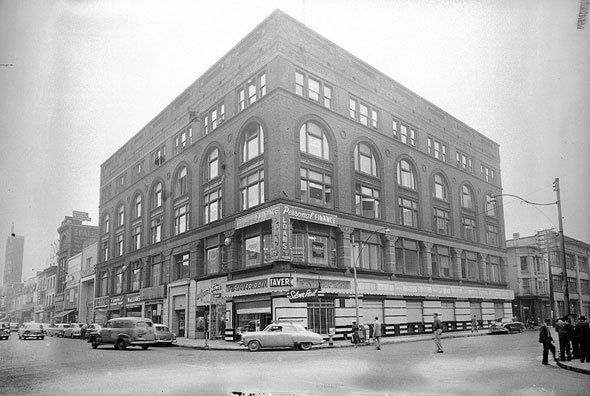
Toronto took a long time to emerge from the paranoid prohibition years between 1916 and 1927. With the formation of the Liquor Control Board of Ontario and a slight loosening of the rules, taverns were eventually allowed to serve beer and wine - no liquor, and certainly no cocktails - before 1930.
In 1947, the LCBO relaxed a little more and issued the province's first cocktail licenses and the spectacular neon and chrome Silver Rail at Yonge and Shuter streets was first (by a hair) to obtain one of the coveted permits. Its liquor menu featured a dazzling range of whiskies, brandies, champagnes, rums, liqueurs, egg nogs, gins, sours, "long tails, and flips."
Jazz legend Charlie Parker drank at the Silver Rail before a now legendary performance with Bud Powell, Charles Mingus, Max Roach, and Dizzy Gillespie across the street at Massey Hall. Pianist Oscar Peterson was played an impromptu concert on the bar's baby grand one night. Metro Toronto chairman Fred Gardiner (he of the expressway) also liked to visit after work.
The Silver Rail met its demise in 1998 when the landlords decided to replace it with a Bay outlet.
THE FIRST COFFEE SHOP
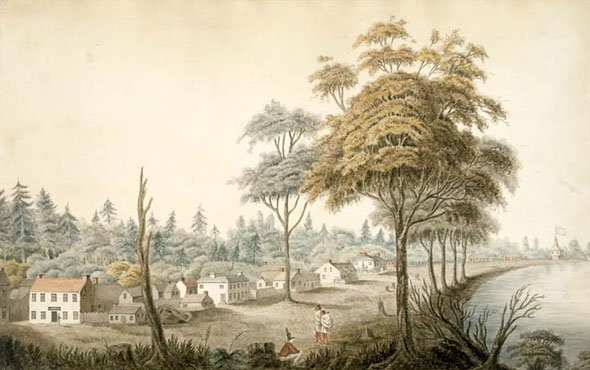
The Toronto Coffee House could rightfully lay claim to two firsts: it was the earliest business to use the word "Toronto" in its name and it was the first public meeting place to style itself after European coffee houses. Opened in 1801 on the east side of Jarvis Street, just north of Front Street, the two-storey building really didn't operate much like a modern coffee shop.
Owner-operator William Cooper, who was at times a teacher, wharf operator, and the town's coroner despite having no formal training in the field, described his business "as nearly on the footing of an English inn as local circumstances" allowed. It served wine, brandy, gin, lime juice, and London porter beer as well as food: "oysters, red herring, and anchovies." There was also a dry goods business and inn under the same roof.
Cooper chose the name in an attempt to position the business as a European-style meeting place, a shrine to conversation and a hub for the local community. He sold the business in 1806 to focus on his Humber River mill.
Please share this
'Arrest me': War of words between Toronto Mayor Rob Ford,Police Chief Bill Blair escalates
TORONTO - Mayor Rob Ford raised the stakes Thursday in the Ford brothers all-out war of words with Toronto Police Chief Bill Blair.
Ford dared Blair to arrest him, endorsed Councillor Doug Ford’s complaint against the chief, questioned the cost of Project Brazen 2 — the ongoing investigation into the mayor and the mayor’s office — and argued Blair should be apologizing to taxpayers for spending money investigating his behaviour.
“If he is going to arrest me, arrest me,” Ford said. “I have done nothing wrong and he’s wasted millions of dollars.
“I want him to come clean and say how much money did it cost the taxpayers for surveillance on me.”
The mayor of Canada’s largest city was firing back at the city’s top cop a day after Blair said he was “deeply offended” by Ford’s inebriated rant at the Steak Queen where he called the chief a “c---sucker.”
“I do not owe him an apology, I will not give him an apology,” Ford said in response to Blair’s public comments.
Ford — who has admitted to smoking crack cocaine — dismissed the results of the investigation that have been made public in police documents.
“Coming up with me urinating in a parking lot? Coming up with an empty vodka bottle? Come on, please,” he said.
A fired-up Ford dismissed Blair’s claim that he was embarrassed by the mayor’s comments about him during his rant in Jamaican patois at Steak Queen in Etobicoke.
“He’s embarrassed? How about him embarrassing my family, my kids, my community, my friends? Following me around for five months, spending millions of dollars,” Ford said. “If there is anyone who owes an apology, he owes an apology to the taxpayers.”
Ford maintained he did “nothing illegal” at the restaurant in January.
“I can go out and if I chose to do that with my friends, I did nothing illegal at Steak Queen,” he said.
Asked about his relationship with Alexander “Sandro” Lisi, Ford refused to talk about the man charged with extortion in connection with the mayor’s crack video.
“I cannot talk about Mr. Lisi, it is before the courts,” he said.
Toronto Police spokesman Mark Pugash wouldn’t comment on Ford’s statements.
“We don’t comment on ongoing, criminal investigations,” Pugash said.
Mayoral candidate John Tory issued a statement blasting Ford over his rant.
“This is a disgrace. Torontonians deserve better,” Tory stated. “While mayors across Canada are focused on building transit and attracting jobs, Doug and Rob Ford are focused on fighting the police chief.
“I am proud to support the chief. Today’s behaviour underscores why we need new leadership at City Hall.”
Spokesman Supriya Dwivedi said mayoral candidate David Soknacki supports the chief and finds Ford’s latest comments “extremely disconcerting, yet he is unfortunately not surprised by the bullying tactics employed by the mayor.”
Please share this
Ford dared Blair to arrest him, endorsed Councillor Doug Ford’s complaint against the chief, questioned the cost of Project Brazen 2 — the ongoing investigation into the mayor and the mayor’s office — and argued Blair should be apologizing to taxpayers for spending money investigating his behaviour.
“If he is going to arrest me, arrest me,” Ford said. “I have done nothing wrong and he’s wasted millions of dollars.
“I want him to come clean and say how much money did it cost the taxpayers for surveillance on me.”
The mayor of Canada’s largest city was firing back at the city’s top cop a day after Blair said he was “deeply offended” by Ford’s inebriated rant at the Steak Queen where he called the chief a “c---sucker.”
“I do not owe him an apology, I will not give him an apology,” Ford said in response to Blair’s public comments.
Ford — who has admitted to smoking crack cocaine — dismissed the results of the investigation that have been made public in police documents.
“Coming up with me urinating in a parking lot? Coming up with an empty vodka bottle? Come on, please,” he said.
A fired-up Ford dismissed Blair’s claim that he was embarrassed by the mayor’s comments about him during his rant in Jamaican patois at Steak Queen in Etobicoke.
“He’s embarrassed? How about him embarrassing my family, my kids, my community, my friends? Following me around for five months, spending millions of dollars,” Ford said. “If there is anyone who owes an apology, he owes an apology to the taxpayers.”
Ford maintained he did “nothing illegal” at the restaurant in January.
“I can go out and if I chose to do that with my friends, I did nothing illegal at Steak Queen,” he said.
Asked about his relationship with Alexander “Sandro” Lisi, Ford refused to talk about the man charged with extortion in connection with the mayor’s crack video.
“I cannot talk about Mr. Lisi, it is before the courts,” he said.
Toronto Police spokesman Mark Pugash wouldn’t comment on Ford’s statements.
“We don’t comment on ongoing, criminal investigations,” Pugash said.
Mayoral candidate John Tory issued a statement blasting Ford over his rant.
“This is a disgrace. Torontonians deserve better,” Tory stated. “While mayors across Canada are focused on building transit and attracting jobs, Doug and Rob Ford are focused on fighting the police chief.
“I am proud to support the chief. Today’s behaviour underscores why we need new leadership at City Hall.”
Spokesman Supriya Dwivedi said mayoral candidate David Soknacki supports the chief and finds Ford’s latest comments “extremely disconcerting, yet he is unfortunately not surprised by the bullying tactics employed by the mayor.”
Please share this
Peter Worthington remembered on Newspaper Day
TORONTO - The Toronto Sun’s founding editor, Peter Worthington, was fondly remembered during Newspaper Day 2014 ceremonies on Thursday.
The event, held by the Advertising Club of Toronto at the Arcadian Court downtown, featured awards and speeches from professionals in the newspaper industry, focusing on achievements by the print advertising community.
Toronto Sun Publisher Mike Power recalled the time Worthington filed his own obituary a few years before his May 12, 2013 death.
“He didn’t trust anyone to write it,” Power joked.
A Second World War veteran who traveled the globe in search of a good story, Worthington was considered “a compass for everyone at the Sun,” he said.
“If there was a big issue or a big story, people would go to him,” Power said.
Worthington joined the Toronto Telegram in 1956, working as a foreign correspondent.
When the paper folded, he was one of the primary figures — along with Doug Creighton and Don Hunt — who pushed to start the Toronto Sun in 1971.
He was fearless, honest, and didn’t stop working until a few weeks before he passed away, Power noted.
“Peter’s version of retirement was writing 40 to 50 hours a week and coming in to the office, which he did until about a month before he died,” he said. “He was a great man and he is missed and will always be remembered by those he touched.”
Please share this
The event, held by the Advertising Club of Toronto at the Arcadian Court downtown, featured awards and speeches from professionals in the newspaper industry, focusing on achievements by the print advertising community.
Toronto Sun Publisher Mike Power recalled the time Worthington filed his own obituary a few years before his May 12, 2013 death.
“He didn’t trust anyone to write it,” Power joked.
A Second World War veteran who traveled the globe in search of a good story, Worthington was considered “a compass for everyone at the Sun,” he said.
“If there was a big issue or a big story, people would go to him,” Power said.
Worthington joined the Toronto Telegram in 1956, working as a foreign correspondent.
When the paper folded, he was one of the primary figures — along with Doug Creighton and Don Hunt — who pushed to start the Toronto Sun in 1971.
He was fearless, honest, and didn’t stop working until a few weeks before he passed away, Power noted.
“Peter’s version of retirement was writing 40 to 50 hours a week and coming in to the office, which he did until about a month before he died,” he said. “He was a great man and he is missed and will always be remembered by those he touched.”
Please share this
Wednesday, February 26, 2014
Big city mayors ask feds for housing, gridlock cash
OTTAWA - Big city mayors say Canada loses $10 billion annually to gridlock and that a housing crisis looms without more guaranteed funding from the feds.
Vancouver Mayor Gregor Robertson said cities need to know they'll get the "lion's share of new funding" and that the funding needs to be "protected" in the next federal budget.
"Cities should be doing more to keep Canada competitive," Robertson said Wednesday.
Lack of affordable housing and "crippling" traffic dissuade investors and makes recruitment difficult for Canadian cities, Robertson said.
A few days before the Federation of Canadian Municipalities (FCM) descended on the capital, the Canadian Federation of Independent Business (CFIB)released a report accusing the FCM of exaggerating its plight - at least financially.
The FCM's longtime claim that cities receive roughly eight cents on the dollar was really more like 15 cents when municipal fees and transfer payments from the provinces are included, the report states.
"I don't take issue with their calculations, just the way they're using their data," CFIB vice-president Laura Jones said.
But even Jones admitted that "no, that doesn't take aware from the seriousness of these urban issues."
Present for the first time at a FCM meeting was Toronto's crack-smoking mayor in name only, Rob Ford.
His message to the feds was that of the $14 billion New Building Canada Fund, of which $10 billion is for provincial and territorial projects of national interest, "I want my fair share."
"We need money for housing and subways," Ford said.
NDP urban critic Matthew Kellway said cities should be a higher federal priority.
"Cities are where Canada interfaces with the rest of the world," he said.
Please share this
Vancouver Mayor Gregor Robertson said cities need to know they'll get the "lion's share of new funding" and that the funding needs to be "protected" in the next federal budget.
"Cities should be doing more to keep Canada competitive," Robertson said Wednesday.
Lack of affordable housing and "crippling" traffic dissuade investors and makes recruitment difficult for Canadian cities, Robertson said.
A few days before the Federation of Canadian Municipalities (FCM) descended on the capital, the Canadian Federation of Independent Business (CFIB)released a report accusing the FCM of exaggerating its plight - at least financially.
The FCM's longtime claim that cities receive roughly eight cents on the dollar was really more like 15 cents when municipal fees and transfer payments from the provinces are included, the report states.
"I don't take issue with their calculations, just the way they're using their data," CFIB vice-president Laura Jones said.
But even Jones admitted that "no, that doesn't take aware from the seriousness of these urban issues."
Present for the first time at a FCM meeting was Toronto's crack-smoking mayor in name only, Rob Ford.
His message to the feds was that of the $14 billion New Building Canada Fund, of which $10 billion is for provincial and territorial projects of national interest, "I want my fair share."
"We need money for housing and subways," Ford said.
NDP urban critic Matthew Kellway said cities should be a higher federal priority.
"Cities are where Canada interfaces with the rest of the world," he said.
Please share this
Toronto Councillors choosing sides in Gardiner debate
TORONTO - Deputy mayor Norm Kelly wants to slam the brakes on talk of tearing down the Gardiner Expy. while councillors are talking about adding a second deck on top of it or introducing tolls to build a better road.
City staff recommended removing the elevated highway east of Jarvis St. early this week, setting City Hall on the road to a contentious debate over the future of the Gardiner.
Kelly advocated Wednesday maintaining the Gardiner until the city can figure out how to get the economic benefits of removing Gardiner while maintaining ability to move people and goods in and out of the downtown.
Councillor David Shiner floated the idea of building a second deck on both the Gardiner and the Don Valley Pkwy. as the only way to “fix” the highway.
Councillor Peter Milczyn argued the city should replace the eastern stretch with an improved option and look at tolls as a way to fund the project. “While there are benefits to dismantling the Gardiner, you can’t ignore the challenges it will therefore present to the gridlock that we experience today,” Kelly said. “If you’re going to have a serious argument that looks meaningfully at the options, you’ve got to have those other options in place or legislatively committed to before you make any decision on the Gardiner.”
Shiner said adding a second deck to the Gardiner and possibly a second level to the DVP would help handle the traffic capacity.
“We’ve cancelled every other expressway and major route coming into Toronto,” Shiner said. “You pay for it out of your infrastructure costs, you pay for it from your development charges.”
Milczyn said the city has a “history of dithering” rather than doing “the right thing, the bold thing.”
“There are four options on the table, one of them is a replace option, I would favour the replace option,” Milczyn said. “We should say we want a (public-private partnership) to deal with that. You maintain the capacity in some form and you also achieve the urban design goals and you create more land value.”
He hoped council would have staff look at a toll as a way to minimize the property tax impact of an improved Gardiner.
Grant Humes, executive director of the Toronto Financial District BIA, appeared at a press conference with Kelly to urge councillors to ask “hard questions” about removing the road.
“(Tearing it down) is clearly not the right thing to do at this point in time,” Humes said. “There are too many unanswered questions related to it.”
Please share this
City staff recommended removing the elevated highway east of Jarvis St. early this week, setting City Hall on the road to a contentious debate over the future of the Gardiner.
Kelly advocated Wednesday maintaining the Gardiner until the city can figure out how to get the economic benefits of removing Gardiner while maintaining ability to move people and goods in and out of the downtown.
Councillor David Shiner floated the idea of building a second deck on both the Gardiner and the Don Valley Pkwy. as the only way to “fix” the highway.
Councillor Peter Milczyn argued the city should replace the eastern stretch with an improved option and look at tolls as a way to fund the project. “While there are benefits to dismantling the Gardiner, you can’t ignore the challenges it will therefore present to the gridlock that we experience today,” Kelly said. “If you’re going to have a serious argument that looks meaningfully at the options, you’ve got to have those other options in place or legislatively committed to before you make any decision on the Gardiner.”
Shiner said adding a second deck to the Gardiner and possibly a second level to the DVP would help handle the traffic capacity.
“We’ve cancelled every other expressway and major route coming into Toronto,” Shiner said. “You pay for it out of your infrastructure costs, you pay for it from your development charges.”
Milczyn said the city has a “history of dithering” rather than doing “the right thing, the bold thing.”
“There are four options on the table, one of them is a replace option, I would favour the replace option,” Milczyn said. “We should say we want a (public-private partnership) to deal with that. You maintain the capacity in some form and you also achieve the urban design goals and you create more land value.”
He hoped council would have staff look at a toll as a way to minimize the property tax impact of an improved Gardiner.
Grant Humes, executive director of the Toronto Financial District BIA, appeared at a press conference with Kelly to urge councillors to ask “hard questions” about removing the road.
“(Tearing it down) is clearly not the right thing to do at this point in time,” Humes said. “There are too many unanswered questions related to it.”
Please share this
Sunday, February 23, 2014
When the Raptors and Leafs moved to the ACC
 It
was 15 years ago this week the Maple Leafs and Montreal Canadiens took
the ice at the Air Canada Centre for the first time. The game was the
first NHL outing for the Buds away their spiritual home, Maple Leaf
Gardens, where they had won 11 of their 13 Stanley Cups.
It
was 15 years ago this week the Maple Leafs and Montreal Canadiens took
the ice at the Air Canada Centre for the first time. The game was the
first NHL outing for the Buds away their spiritual home, Maple Leaf
Gardens, where they had won 11 of their 13 Stanley Cups.How the Leafs wound up in a former mail sorting facility behind Union Station is a tale of basketball, buyouts, and, most importantly, big money. The tale starts in 1993 with the awarding of a lucrative NBA expansion franchise to Toronto businessman John Bitove.
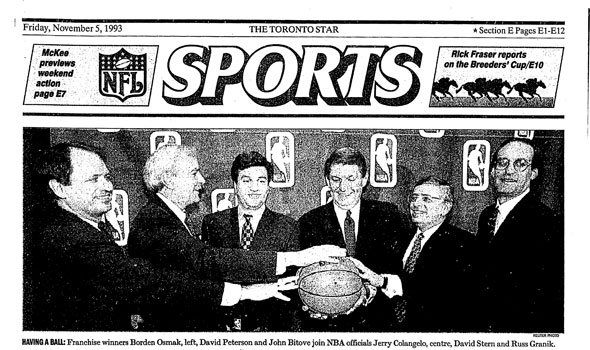 "Hoop, hoop, horray!" read The Toronto Star
headline. "It's unanimous! NBA gives approval to T.O. franchise." The
27-member board of the National Basketball Association had approved a
return of pro-basketball to Canada almost 50 years after the short-lived
Toronto Huskies folded in 1947. The cost to start the new team: $125
million (US.)
"Hoop, hoop, horray!" read The Toronto Star
headline. "It's unanimous! NBA gives approval to T.O. franchise." The
27-member board of the National Basketball Association had approved a
return of pro-basketball to Canada almost 50 years after the short-lived
Toronto Huskies folded in 1947. The cost to start the new team: $125
million (US.)As owner of the as-yet unnamed Toronto team, one of Bitove's first challenges was to build an arena. The team had secured permission to play on the floor of the massive 29,000 capacity Skydome in during the 1995 season but after that the team planned to move to an arena at the southwest corner of Bay and Dundas, which was to be called Centre Court.
It was a good thing too: Fans in the 500 level, those closest to the roof of the cavernous Skydome, complained they could barely see the action on the wooden court some 70 metres below.
The $100 million Centre Court would seat 20,000 and have room for 150 corporate boxes, the team said.
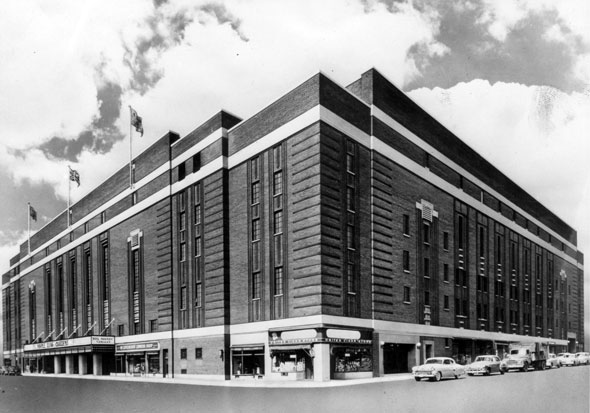 Meanwhile, the Toronto Maple Leafs were bursting at the seams on Carlton Street.
Maple Leaf Gardens had provided the backdrop for the team's biggest
successes but the relatively small number of seats, lack of corporate
boxes, and the associated loss of potential revenue were becoming a
source of internal friction.
Meanwhile, the Toronto Maple Leafs were bursting at the seams on Carlton Street.
Maple Leaf Gardens had provided the backdrop for the team's biggest
successes but the relatively small number of seats, lack of corporate
boxes, and the associated loss of potential revenue were becoming a
source of internal friction.The two expansion teams that joined the National Hockey League in 2000, the Minnesota Wild and Columbus Blue Jackets, could both comfortably accommodate 2,000 more fans than the much-loved Leafs in newly built stadiums. The Gardens had been hastily thrown together in just over six months in 1931 and thousands of extra seats had been squeezed in over the decades, increasing capacity by a fifth but leaving little remaining space.
As Mark Osbaldeston wrote in his book Unbuilt Toronto 2: More of the City That Might Have Been, a stadium that could accommodate the soon-to-be Raptors and the Leafs made financial sense but the Bay and Dundas site was too small to accommodate both sports.
As a result, the Raptors bought the empty former Toronto central mail terminal, an old art deco building at Bay and Lake Shore. On the building's exquisite exterior, a series of 13 carvings by Louis Temporale Sr. depicted the history of communications in Canada.
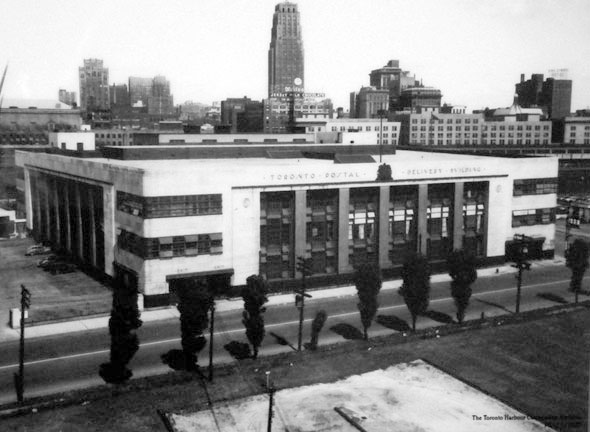 With
the purchase of the historic building - one of the first in the city to
incorporate international style features - and a small patch of former
railway lands, the Air Canada Centre was conceived. Canada's national
carrier purchased the naming rights to the stadium for $30 million in
1995 and the Raptors planned to break ground on the project in November
1996, but a change of ownership would put paid to that.
With
the purchase of the historic building - one of the first in the city to
incorporate international style features - and a small patch of former
railway lands, the Air Canada Centre was conceived. Canada's national
carrier purchased the naming rights to the stadium for $30 million in
1995 and the Raptors planned to break ground on the project in November
1996, but a change of ownership would put paid to that. Founder and president John Bitove was forced to sell his stake in the team to fellow shareholder Allan Slaight in a surprise "shotgun" agreement, giving Slaight 79% ownership. The newly empowered Slaight was in talks with construction tycoon and Leafs shareholder Larry Tanenbaum about the possibility of a stadium sharing agreement.
Slaight didn't see any major obstacles "as long as everybody [kept] an open mind."
The Leafs, meanwhile, were still trying hard to lure the Raptors away from the ACC, which the team believed would be too small for NHL hockey. The Buds were eyeing the possibility of new stadiums at the Exhibition grounds, near the Skydome, Varsity Stadium, and at Downsview.
Then the team did something few people saw coming.
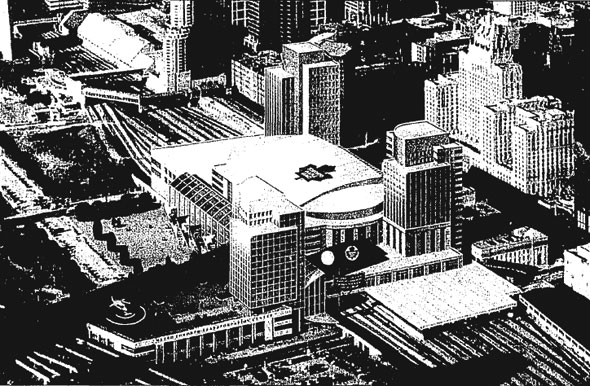 On
April 17, 1997 the Leafs revealed plans to build an entirely new hockey
arena a stone's throw from the Air Canada Centre, directly above the
tracks of Union Station. The stadium would share the grand entrance of
Toronto's railway terminal on Front Street and include a tower similar
in design to one planned for the ACC.
On
April 17, 1997 the Leafs revealed plans to build an entirely new hockey
arena a stone's throw from the Air Canada Centre, directly above the
tracks of Union Station. The stadium would share the grand entrance of
Toronto's railway terminal on Front Street and include a tower similar
in design to one planned for the ACC.Most importantly, the proposal did not foresee the Raptors as neighbours. Under the Leafs' plans, the postal station would be turned into a bus terminal and the basketball franchise moved under the same roof as the hockey team - too bad if the Raptors were already $80 million in the hole for the ACC and were obliged to be ready for the start of the 1999 NBA season.
As Osbaldeston wrote, the trouble was the Leafs didn't actually own the property the team planned to build on (and over.) Union Station was on land owned by the city and leased to the Canadian Pacific Railway and Canadian National Railway.
The two rail companies were locked in a dispute with the city over millions in unpaid rent. The Leafs offered to cover CPR and CNR's costs and pay an additional $50 million on top for the land rights. There were additional sweeteners, too.
The Leafs balked at a counter offer from the city that would have cost the team significantly more. In a last ditch effort to reverse its fortunes, full-page ads were printed in Toronto newspapers appealing for public support.
It wasn't to be, however, and the team turned its focus once again to a stadium at the Exhibition grounds that appeared to have the support of city.
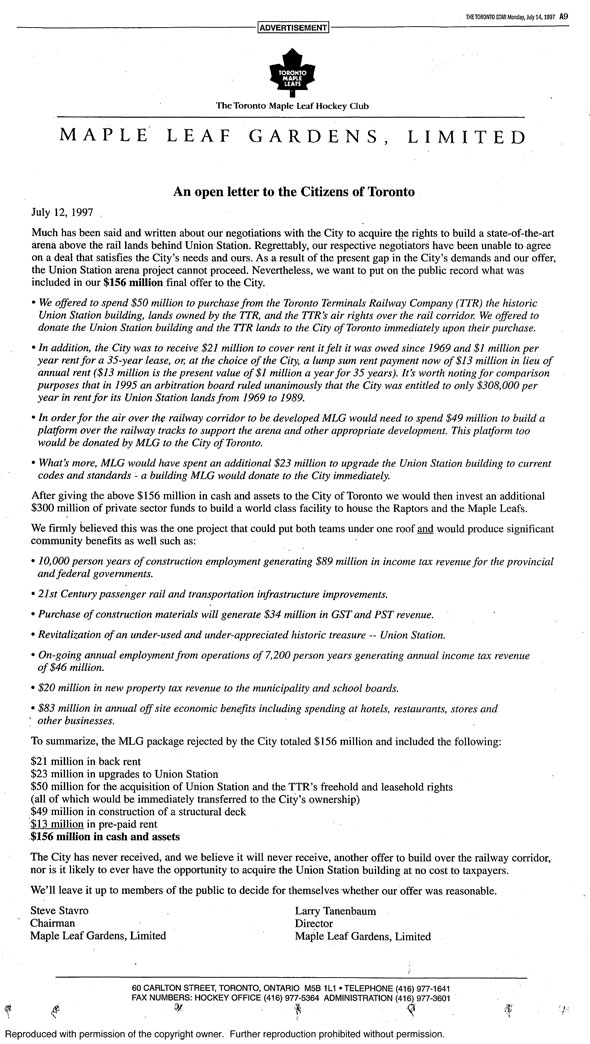
In early 1998, the Leafs deked in a new direction entirely and bought the Raptors and their unfinished Bay Street arena wholesale. The team initially clung to the idea of a grand entrance through Union Station on Front Street but eventually dropped that idea too.
The Air Canada Centre opened in 1999 with both the Raptors and Leafs best friends.
Please share this
Wednesday, February 19, 2014
Map project ties together centuries of Toronto history
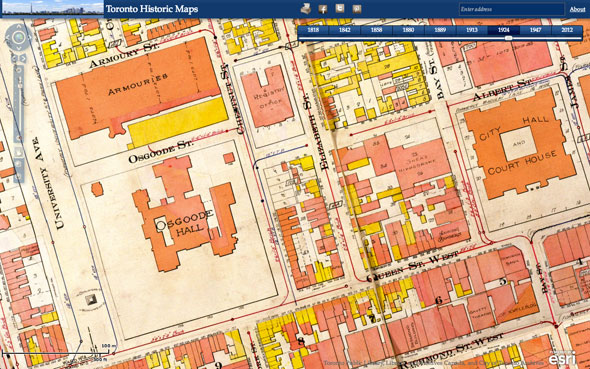 Imagine
standing at the corner of Queen and Bay and being able to fast-forward
through time from 1818 right up to present day. Two city halls, polar
opposites in terms of design, would appear before your eyes, the mighty
Eaton's department store empire would proliferate and crumble, and rows
of industrial buildings would give way to luxury hotels and bank
buildings.
Imagine
standing at the corner of Queen and Bay and being able to fast-forward
through time from 1818 right up to present day. Two city halls, polar
opposites in terms of design, would appear before your eyes, the mighty
Eaton's department store empire would proliferate and crumble, and rows
of industrial buildings would give way to luxury hotels and bank
buildings.Chris Olsen, a professional cartographer based in Redlands, California, has made that dream a reality with a gorgeous interactive map application. Released earlier this month, the Google Maps-style interface lets users explore maps of Toronto that date back almost two centuries.
"It really gives you a window into the evolution of the city," says Nathan Ng, who supplied some of the image files used by Olsen. "If you look at the area around Old City Hall and zoom through the years you can see how The Ward changed, and by 1947 it's all different."
Olsen, who works for Esri, a geographic information systems software company based in Redlands, California, has made similar maps of Cleveland and Pittsburgh in his spare time and was challenged to do something for Toronto by Ng.
The result is a timeline of maps from 1818 to 1924 with aerial views from 1947 and 2012. The maps Olsen used for 1889, 1913, and 1924 were prepared for insurance underwriters and printed as 59 separate plates.
Zoom out far enough and the patchwork is visible due to minor variances in colour and tone.
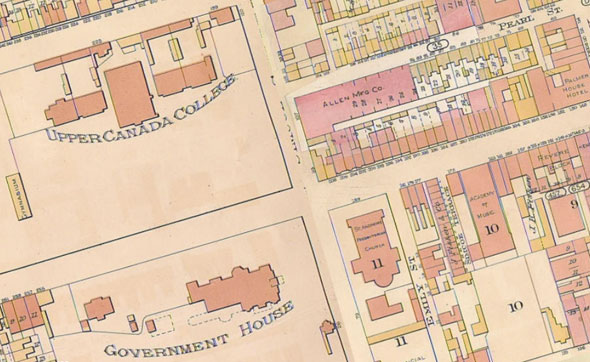 "The
most time consuming part is putting the maps together because you're
starting with just the pure image itself," Olsen says. It took about to
six months to stitch the pieces together, make the map searchable, and
work out numerous tiny inaccuracies, he says.
"The
most time consuming part is putting the maps together because you're
starting with just the pure image itself," Olsen says. It took about to
six months to stitch the pieces together, make the map searchable, and
work out numerous tiny inaccuracies, he says."Everything that I've done is out-of-the-box, there's no customizing or smoke and mirrors or anything like that."
The attention to detail is remarkable: Each map has been rotated to true north, which puts Toronto's streets at their correct oblique angle, and synchronized with an address search function. It's possible to find a location and adjust the slider to see how the neighbourhood evolved.
Take King and Simcoe. In 1818 it's a rural crossroads on the outskirts of town. By 1889, the arrival of Upper Canada College, Government House, St. Andrew's Church, and the bawdy British Hotel tavern has resulted in corners being nicknamed "education," "legislation," "salvation," and "damnation."
Jump ahead to 1924 and the block is dominated by rail sidings and factories; leap ahead again and King and Simcoe is the heart of the theatre district, home to Roy Thomson Hall and Metro Centre.
Every point on the map has its own story to tell. Try it for yourself
Please share this
Maria Augimeri appointed new TTC chair

Veteran councillor Maria Augimeri is the new TTC chair. Late this afternoon, 23 members of council carefully wrote the name of the long-time York Centre representative on their sheet of blue ballot paper, two more than for rival Councillor Josh Colle.
Augimeri promised to deliver "good, solid work" while in the position but was at pains to position herself as a temporary placeholder. "I'm a very hard worker and I run meetings very well," she said. "I hope with Andy Byford as a partner to move forward to try and claw back the funding we lost from the province so many years ago."
Outgoing chair Stintz will formally resign on Saturday to focus on her upcoming run for mayor in the October election.
Augimeri, a 16-year council veteran, supported the light rail option for Scarborough while Colle, a councillor nearing the end of his first term, voted for a subway extension. It's not expected that either of the candidates will re-visit the issue in the remaining months of this term of council.
"The people have spoken - they've spoken five times, so I say the issue is a closed issue now," she said. "The funding has to be found. I'm disappointed in the extra half per cent people are going to be paying for it, I don't think that's something people swallow very it well, it's a bitter pill."
Mayor Rob Ford tried unsuccessfully to place his brother Councillor Doug Ford on the ballot - only existing TTC board members are eligible to hold the position. Both Ford brothers and Deputy Mayor Norm Kelly voted for Colle.
City council will vote again on a TTC chair following the municipal election later this year.
Please share this
Monday, February 17, 2014
New map shows off the massive park system in Toronto
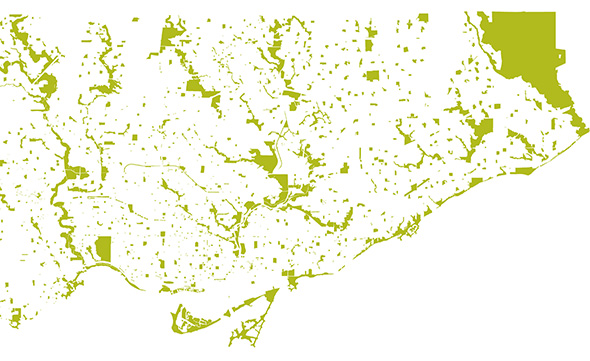 Toronto
has been referred to as "the city within a park," an observation that
tends to ring true when one takes a look at this map put together by
Kyle Baptista of Park People,
a local organization devoted to improving our green space. There are
over 1600 parks plotted on the map above, which naturally stand out
against a background devoid of streets or other cartographic
information.
Toronto
has been referred to as "the city within a park," an observation that
tends to ring true when one takes a look at this map put together by
Kyle Baptista of Park People,
a local organization devoted to improving our green space. There are
over 1600 parks plotted on the map above, which naturally stand out
against a background devoid of streets or other cartographic
information.Perhaps what's most interesting about this map is the degree to which one can easily pick out our ravine systems and long lost rivers. The Humber and Don are, of course the easiest to spot, but a good eye should also be able to locate the remains of Garrison Creek in the spotty remains of parkland running up from Fort York. Other features like the Belt Line Trail and High Park are also a cinch to pick out.
The map is obviously pared down to the barest essentials, but on account of this very strategy, it highlights the degree to which we're spoiled with green space in Toronto. It may be a bit of a challenge to spot your local park on this map, but the next time you're looking to explore for an extended period of time, this could very well be used as a starting point.
Check out a high resolution version of the map here.
Sunday, February 16, 2014
When the Toronto St. Pats became the Maple Leafs
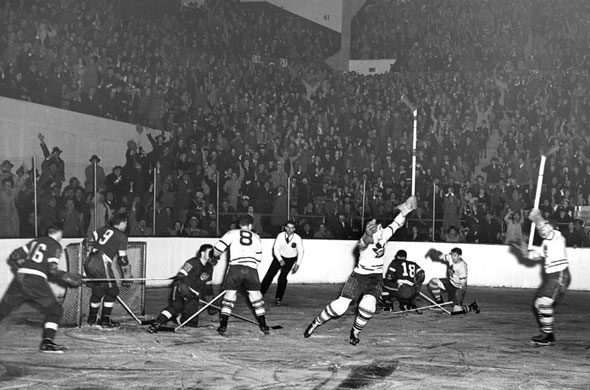 The
Toronto Maple Leafs celebrated a birthday on Friday. It was 87 years
ago this month that the team adopted the grammatically curious Maple
Leafs name and donned the first jersey to bear a version of the iconic
team logo.
The
Toronto Maple Leafs celebrated a birthday on Friday. It was 87 years
ago this month that the team adopted the grammatically curious Maple
Leafs name and donned the first jersey to bear a version of the iconic
team logo.That the Leafs exist at all is a tribute to Conn Smythe, who rescued the beleaguered NHL team from a possible move to Montreal or Philadelphia.
"The intention is to get the Toronto public interested in the team as much as possible and to make the team a Toronto aggregation with some home-town pride," The Toronto Star wrote of the move. "The new owners have the proper sporting spirit and are determined to get a team that will hold its own with the best in the league."
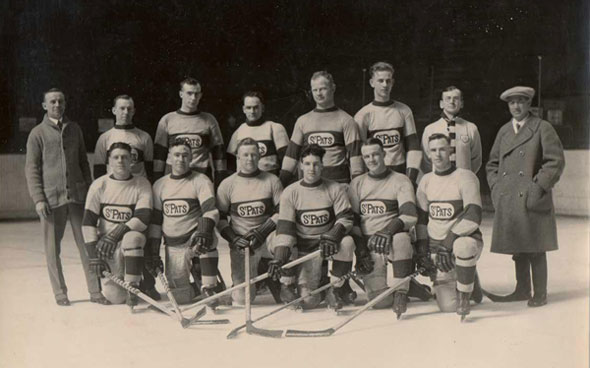 The
years following the end of the first world war hadn't been kind to the
Toronto Arenas, the precursor to the St. Patricks. In 1918, under
manager Charlie Querrie, a legal dispute forced the sale of several star
players, resulting in a five-win season that's still the worst in team
history.
The
years following the end of the first world war hadn't been kind to the
Toronto Arenas, the precursor to the St. Patricks. In 1918, under
manager Charlie Querrie, a legal dispute forced the sale of several star
players, resulting in a five-win season that's still the worst in team
history.Querrie organized a group of investors and bought the team. In 1922, the newly named St. Patricks took the first ever NHL title but, bizarrely, did not have their name engraved on the Stanley Cup - it would have be added 25 years later in 1948. The brief success didn't last and a further legal dispute with a former owner forced Querrie to put the team up for sale again in 1927.
A group from Philadelphia bid $200,000 for the franchise, $40,000 more than the highest local offer, and looked set to claim the St. Pats. Luckily, Querrie was "loath to see the franchise and players leave Toronto" and a group of businessmen from Toronto led by Conn Smythe convinced him to sell to them instead.
"The name 'St. Pats' has been discarded and in the future it will be the 'Maple Leafs' of Toronto," the Star declared following the announcement of the sale on Valentines Day 1927.
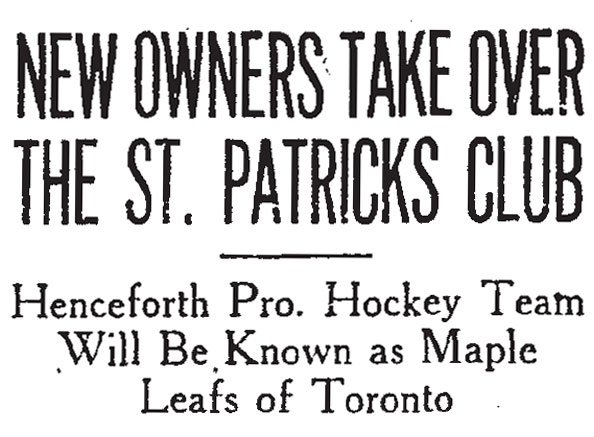 Toronto
already had a Maple Leafs in the form of a Double-A baseball team that
played out of a ball park at Bathurst and Lake Shore. Before that, the
original Leafs had a stadium at Hanlan's Point, where a young Babe Ruth
hit his first professional home run in 1914.
Toronto
already had a Maple Leafs in the form of a Double-A baseball team that
played out of a ball park at Bathurst and Lake Shore. Before that, the
original Leafs had a stadium at Hanlan's Point, where a young Babe Ruth
hit his first professional home run in 1914.The origin of the Maple Leafs name, which at first glance seems like it should be "Maple Leaves," isn't entirely clear. The official story goes that the team was named for the Maple Leaf Regiment of the Canadian army, but there's some suggestion the title was a tribute to yet another Maple Leafs team for whom Conn Smythe worked as a scout.
In his book Centre Ice: The Smythe Family, the Gardens and the Toronto Maple Leafs Hockey Club, Smythe's grandson Thomas Stafford Smythe said the team was named for the insignia his grandfather, a decorated veteran, wore on his uniform during the war.
The Leafs beat the New York Rangers 4-1 in their first game, snapping a lengthy losing streak. "Has the jinx gone?" wrote sports writer Bob Hayes in the Star. "Last night's game was one of the best, if not the best, of the season."
The club wore a white jersey with a green logo for the remainder of the season, switching to the familiar blue and white in 1927-28.
The transformation was complete.
Please share this
Thursday, February 13, 2014
That time a Toronto team won Olympic hockey gold
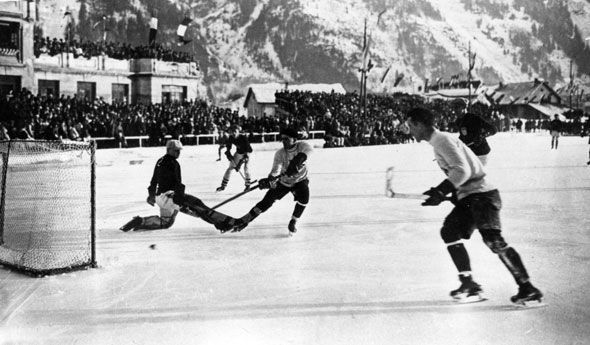 The
2014 men's Olympic hockey squad is a super team of NHL stars from
across the country. As the most talented and highly paid individuals in
their field, they are the Traveling Wilburys of hockey, if you will -
the team could never exist if it hadn't been created.
The
2014 men's Olympic hockey squad is a super team of NHL stars from
across the country. As the most talented and highly paid individuals in
their field, they are the Traveling Wilburys of hockey, if you will -
the team could never exist if it hadn't been created.90 years ago, it was a group of talented amateurs from Toronto who fought for, and eventually took home, Canada's first (and the world's first) winter Olympic gold in hockey at the 1924 Chamonix Olympics. With devastating efficiency they tore through the competition, scoring in bunches. The opposition didn't stand a chance.
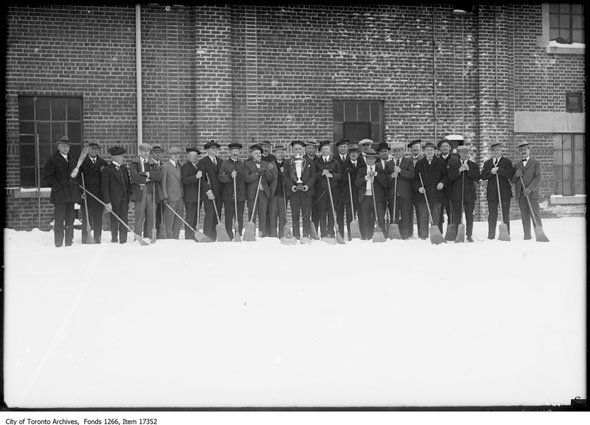 The
Toronto Granite Curling Club was founded by an act of rebellion. Five
of prominent members of the Toronto Curling Club - two bankers, a
politician, a lawyer, and a businessman - decided in 1875 that they were
fed up with the sports society's plan to build a new enclosed rink on
Adelaide Street.
The
Toronto Granite Curling Club was founded by an act of rebellion. Five
of prominent members of the Toronto Curling Club - two bankers, a
politician, a lawyer, and a businessman - decided in 1875 that they were
fed up with the sports society's plan to build a new enclosed rink on
Adelaide Street. The economy was struggling and many of its members viewed the arena as an unnecessary extravagance, record authors Rod Austin and Ted Barris in Carved in Granite: 125 Years of Granite Club History.
With the help of some 30 prominent members, a splinter group was formed. There was William Mellis "Mr." Christie, the namesake of Christie St., Robert Henry Bethune the first general manager of the Dominion Bank, and Robert Jaffray the director of The Globe newspaper, among others.
The first members would soon be joined by Toronto mayor W.B. McMurrich and J.D. Edgar, the speaker of the House of Commons. Sir John A. Macdonald was an honorary patron.
The founders named their new club after the dark grey rock of the Canadian Shield used in their curling stones.
The Granite Club's "uptown" clubhouse, a single-story wood hut surround by an ice sheet, was one of just three curling rinks in the city, and it quickly became a magnet for anyone of a sporting bent. It was also the only club located away from the waterfront, the frozen surface of which became a perfect natural ice sheet in winter.
The Granite Club expanded to a new two-storey red brick premises on Church Street in 1880. At the building's rear sat a massive enclosed rink with enough room for four curling sheets. Before the arrival of artificial ice and Zambonis, simply creating a rink big enough for the club members' needs was a serious undertaking.
"The poor, long-suffering ice man would sit up night after night, waiting for the temperature to drop. When it did, he would throw open the large doors of the rink, don his leather gloves and high rubber boots, and begin sprinkling the floor of the rink with water, adding a little more each time as it froze," Rod Austin and and Ted Barris write.
"Then, using hot water from a watering can, he would 'pebble' the surface to produce a beautiful checkerboard appearance. Ice making in the 19th century was not only hard work, it was also an art."
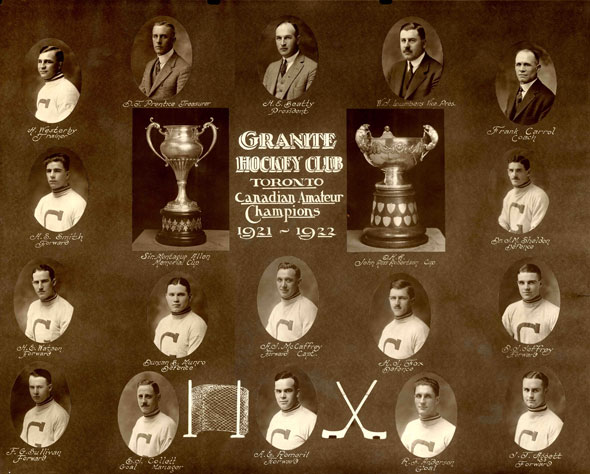 The
Granite Club's various curling teams had plenty of success but it was
its men's hockey team that would make the biggest sporting impact.
The
Granite Club's various curling teams had plenty of success but it was
its men's hockey team that would make the biggest sporting impact.In the early 1920s, the Toronto Granites were an emerging force in the Ontario Hockey Association. Under the guidance of Toronto Star sports editor William A. Hewitt, father of broadcaster Foster Hewitt, the team won the 1920 John Ross Robertson Cup, beating the Hamilton Tigers on aggregate over two games.
The team switched to the Allen Cup, the trophy awarded to the national amateur champions, in 1922, taking back-to-back wins against the Regina Victorias and University of Saskatchewan respectively.
The win against the University of Saskatchewan was particularly hard fought. The collegiate side repeatedly breached the Granites' defence only to be denied by the calm heroics of goalie Jack Cameron.
Forward Harry Watson - dubbed the "bad man" in the "Ambitious City" - scored the first goal for the Granites in front of some 6,000 rabid Winnipeg fans, many of whom had been in line for tickets since before dawn. Hard work over two games by captain Dunc Munro and forward "Hooley" Smith proved pivotal, leading to a 11-2 final score after two games.
As was customary until 1960, the Allen Cup champions in an Olympic year were automatically selected to represent Canada against the world.
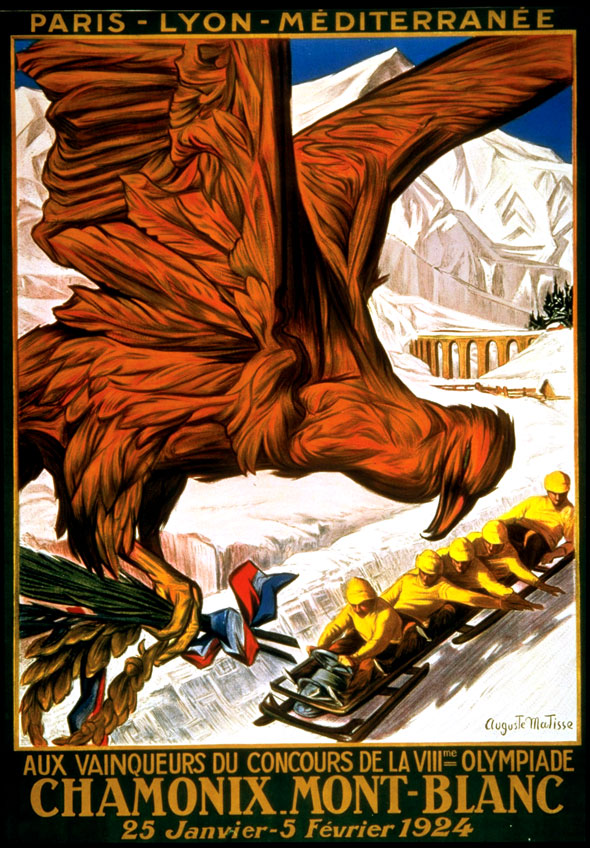 1924
was a special year for the Olympics as it was. For the first time in
the modern era, the event would be divided in two: one event for summer
sports, another for winter, both played in the same country a few months
apart.
1924
was a special year for the Olympics as it was. For the first time in
the modern era, the event would be divided in two: one event for summer
sports, another for winter, both played in the same country a few months
apart.The little alpine village of Chamonix, tucked in the imposing shadow of Mount Blanc, would host hockey, bobsleigh, figure skating, and winter patrol - a cross-country combination of skiing, rifle shooting, and mountaineering that would eventually morph into the biathlon - while Paris would be the site of the summer games a few months later.
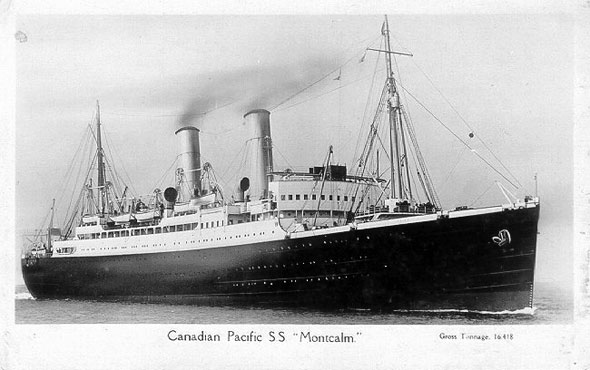 The
Toronto Granites left for Europe with several new players aboard the
RMS Montcalm on Jan. 11, 1924. A vicious winter storm had whipped the
Bay of Fundy into a nauseating froth. Forward "Hooley" Smith bet Toronto Evening Telegram
writer Harry Watson that he wouldn't be seasick, and lost. The next
morning only three of the nine-man squad made it to breakfast.
The
Toronto Granites left for Europe with several new players aboard the
RMS Montcalm on Jan. 11, 1924. A vicious winter storm had whipped the
Bay of Fundy into a nauseating froth. Forward "Hooley" Smith bet Toronto Evening Telegram
writer Harry Watson that he wouldn't be seasick, and lost. The next
morning only three of the nine-man squad made it to breakfast. "[Dunc Munro] was afraid he was going to die; the next day he was afraid he was not going to die," Watson wrote.
The team arrived in Chamonix via London and Paris and were clearly impressed by what they found. William A. Hewitt cabled his bosses at the Toronto Star gushing over the "towering mountains," the glaciers, and the mountain stream that bisected the village.
Also writing for the Star and quoted in Carved in Granite: 125 Years of Granite Club History, captain Dunc Munro sketched out the team's day-to-day activities:
"Mr. Hewitt has the boys under strict discipline. They are to retire at ten o'clock and rise for an eight o'clock breakfast. I may say that by ten o'clock they are all glad to go to bed, as the wonderful air here makes you very tired ... Chamonix is the St. Moritz of France. There are many things to do here, but most of them are out of bounds until after we win the world's championship."
The Olympic hockey games were played outdoors on a natural European-size ice rink, which was considerably bigger than what they were used to in Canada. The Granites were also forced to adapt to tiny 1-foot boards that eliminated heavy body checks and practically all dump-ins. The main hockey stadium was "twice as large at the University of Toronto stadium" and could hold about 5,000 people.
They needn't have been worried by the unfamiliar playing surface because few countries managed to mount a defence against the all-powerful OHA champs. The Granites crushed Sweden, Czechoslovakia and Switzerland without conceding a single goal. Great Britain capitulated 19-2, leaving only the United States between the Canadians and a first Winter Olympic gold.
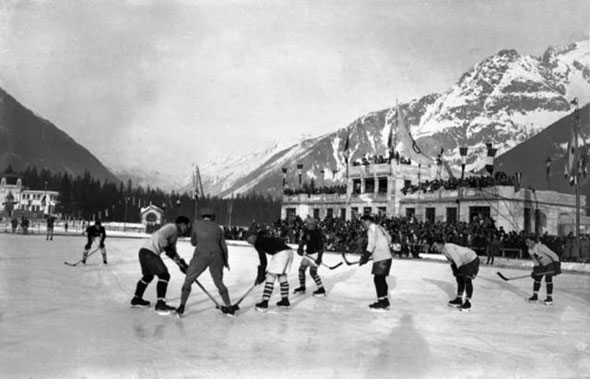 Though
it would have made for a great story - victory in the face of defeat,
an unlikely come from behind win, etc.. - the Americans also didn't
present much of a challenge either. "The Canadians won rather easily,"
wrote the Toronto Star. "Their passing back and forward was a treat. Their teamwork was the predominant feature of the victory."
Though
it would have made for a great story - victory in the face of defeat,
an unlikely come from behind win, etc.. - the Americans also didn't
present much of a challenge either. "The Canadians won rather easily,"
wrote the Toronto Star. "Their passing back and forward was a treat. Their teamwork was the predominant feature of the victory."The Granites stormed to an early two-goal lead with markers from McCaffrey and Watson in the first period. Watson, one of the most talented players on the team, faked and deked through the American defence for the second goal. Spectators called it a thing of beauty.
A deflected shot beat Canadian goalie Jack Cameron for the only American point moments later. Three goals in the second and another in the third from Munro, a stunning individual effort in the mould of Watson's goal earlier in the game, sealed the victory 6-1. It was never close.
Despite a cross-check bursting his lip in the first minute, Harry Watson was the undoubted star of the match. "After the game the Americans declared Watson the greatest hockeyist of all time," The Star wrote. "They said no other player ever took so much punishment and played such brilliant hockey."
Moments later, the band struck up "The Maple Leaf" and the Canadian ensign was raised to the top of the stadium.
Canada had its first hockey gold at the Winter Olympics.
Please share this
5 lost rivers that run under Toronto
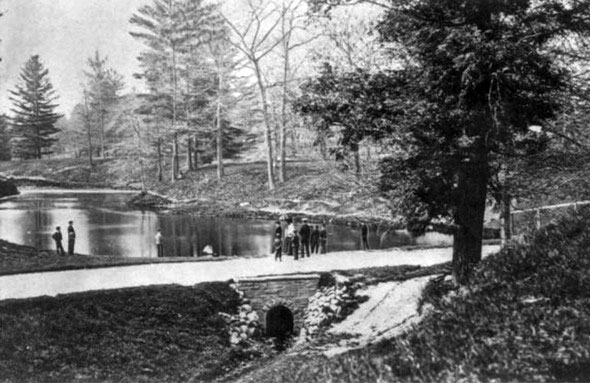 The
Don, Humber, and Rouge get all the glory, but Toronto is much more than
a three-river town. Before John Graves Simcoe, when the land that would
occupy the city was thick with trees and thickets, its soft soil was
traversed by numerous streams and creeks that over centuries etched out
deep ravines and sculpted rolling dales.
The
Don, Humber, and Rouge get all the glory, but Toronto is much more than
a three-river town. Before John Graves Simcoe, when the land that would
occupy the city was thick with trees and thickets, its soft soil was
traversed by numerous streams and creeks that over centuries etched out
deep ravines and sculpted rolling dales.As early city builders would find, it's actually quite difficult to completely erase a river, and many of the waterways that once penetrated downtown Toronto still exist, re-routed into culverts or sewers and (mostly) from view. Here are five buried rivers that used to flow through Toronto.
GARRISON CREEK
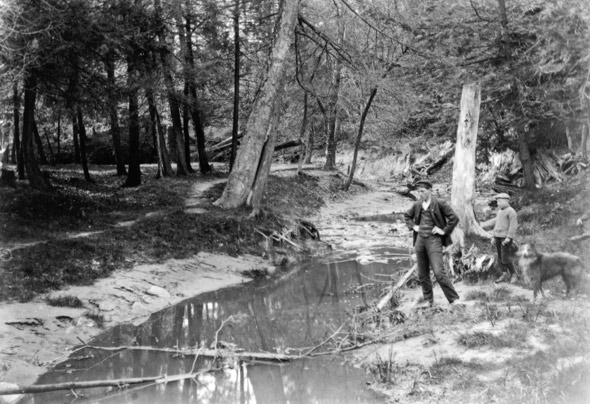 Of
all the rivers present in early Toronto, Garrison Creek was the biggest
and hardest to cross. Its winding course and ocasionally deep ravine
proved a significant obstacle to the expanding city and substantial
bridges were built at Dundas and Harbord streets, both of which have
been buried but still stand.
Of
all the rivers present in early Toronto, Garrison Creek was the biggest
and hardest to cross. Its winding course and ocasionally deep ravine
proved a significant obstacle to the expanding city and substantial
bridges were built at Dundas and Harbord streets, both of which have
been buried but still stand.Garrison Creek started north of St. Clair and headed directly south via Bloor and Christie under a half-buried bridge at Harbord - the stone wall on the north side of the street at Bickford Park is the bridge's parapet. It continued south, causing the weird dips and warped intersection on Crawford Street.
From there, Garrison Creek headed through Trinity Bellwoods Park, where there's another buried bridge under Crawford Street (the dog park is in part of the old ravine,) and out the southeast corner parallel to Niagara Street, where the river bank caused its distinctive arc. Garrison Creek drained into the Toronto Bay near Bathurst and Fort York Blvd.
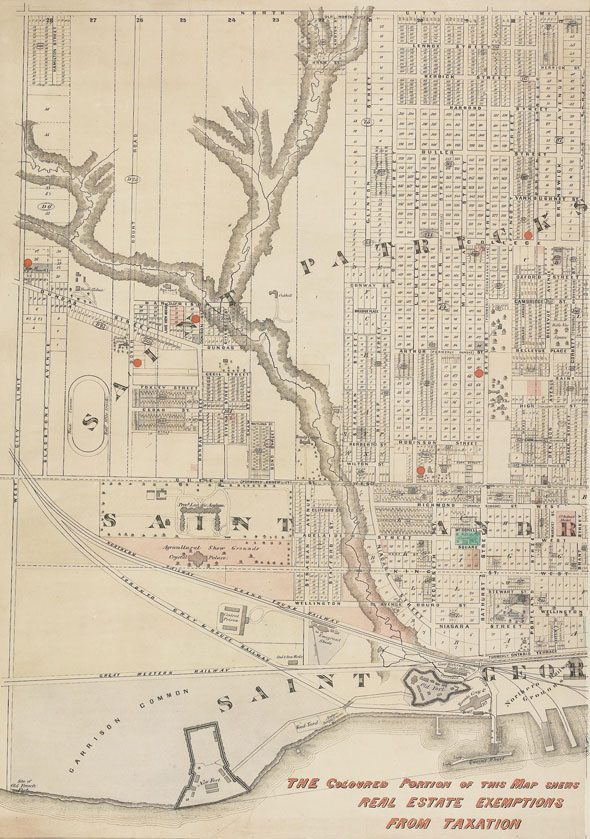 TADDLE CREEK
TADDLE CREEK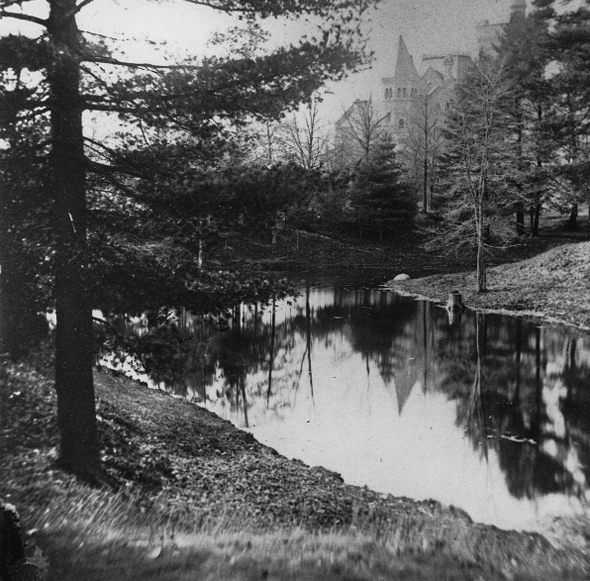 The
geographical legacy of Taddle Creek, sometimes called Little Don River,
is more subtle than that of its westerly cousin Garrison Creek. The odd
dent in the southwest corner of Queen's Park Crescent and the gentle
slope of Parliament just north of King are the extent of the river's
surviving landscaping.
The
geographical legacy of Taddle Creek, sometimes called Little Don River,
is more subtle than that of its westerly cousin Garrison Creek. The odd
dent in the southwest corner of Queen's Park Crescent and the gentle
slope of Parliament just north of King are the extent of the river's
surviving landscaping.Possibly rising at Wychwood Park northwest of Davenport and Bathurst (no-one is entirely certain,) Taddle Creek flowed south along the eastern edge of the University of Toronto campus, forming a small pond at Hart House Circle that shows up early photos of the university grounds.
At College it swerved east, eventually draining into the bay near Parliament and Esplanade.
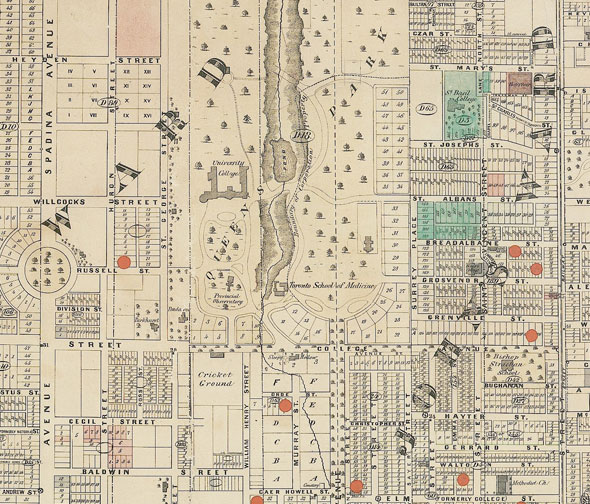 CASTLE FRANK BROOK
CASTLE FRANK BROOK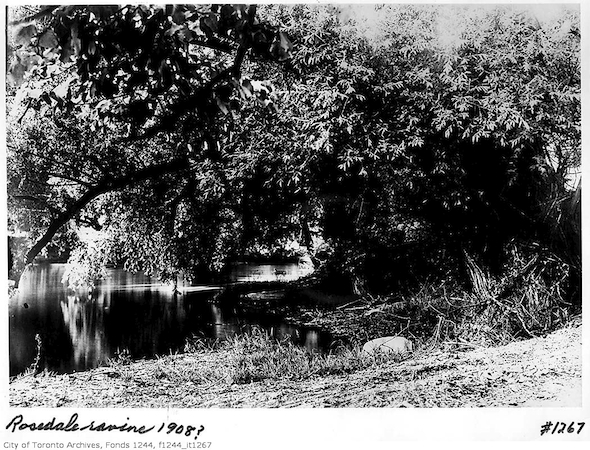 The steep sides of the Rosedale Ravine had to come from somewhere.
Castle Frank Brook, the product of several smaller rivers that met near
Cedarvale Park, eroded the Nordheimer Ravine, which could have carried
the Spadina Expressway but now covers the Spadina line, and the deep
Rosedale Ravine.
The steep sides of the Rosedale Ravine had to come from somewhere.
Castle Frank Brook, the product of several smaller rivers that met near
Cedarvale Park, eroded the Nordheimer Ravine, which could have carried
the Spadina Expressway but now covers the Spadina line, and the deep
Rosedale Ravine.Today, Castle Frank Brook cuts under St. Clair West station, rises again in Sir Winston Churchill Park, and vanishes back into a sewer that carries it down under Rosedale Valley Road into the Don River opposite Riverdale Park.
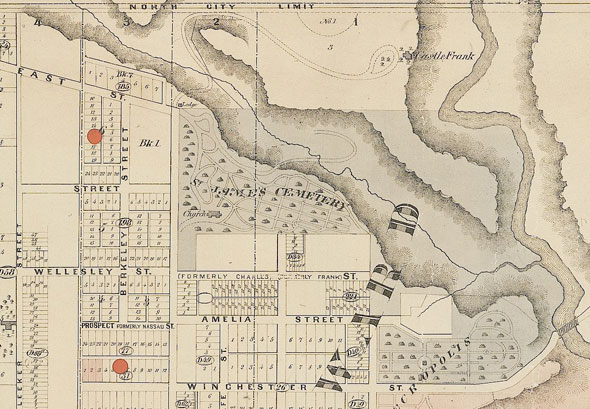 SMALL'S POND
SMALL'S POND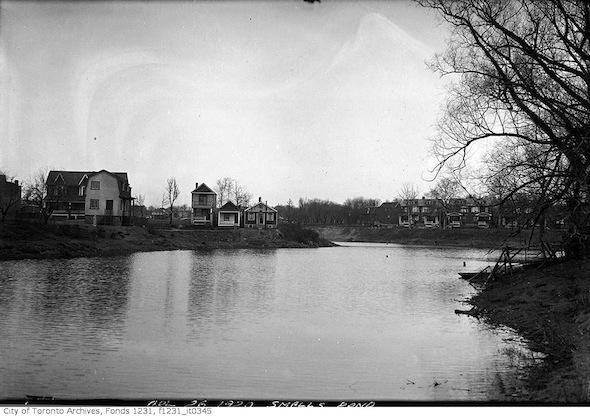 The size of a small lake, Small's Pond once dominated the area close to Queen Street E and Kingston Road.
It was fed by two separate streams, one that started near Gerrard and
Coxwell, the other closer to Woodbine, and was once a prime source of
beverage ice in the winter as many other bodies of water were considered
too polluted.
The size of a small lake, Small's Pond once dominated the area close to Queen Street E and Kingston Road.
It was fed by two separate streams, one that started near Gerrard and
Coxwell, the other closer to Woodbine, and was once a prime source of
beverage ice in the winter as many other bodies of water were considered
too polluted.The 12-metre deep, roughly U-shaped Small's Pond was naturally divided into two separate arms, one of which was popular with skaters and boaters and known locally as The Serpentine. The other, broader arm ran roughly parallel with Coxwell Ave.
In 1919, nine-year-old John Vice drowned in a weed-choked portion of the Small's Pond and the next year two small boys had to be pulled from its dark waters. Small's Pond became a stagnant, sewage-filled pool when its feeder streams were diverted into sewers. It was drained and filled in on health grounds around 1935. Orchard Park roughly marks the place where the two parts of Small's Pond met.
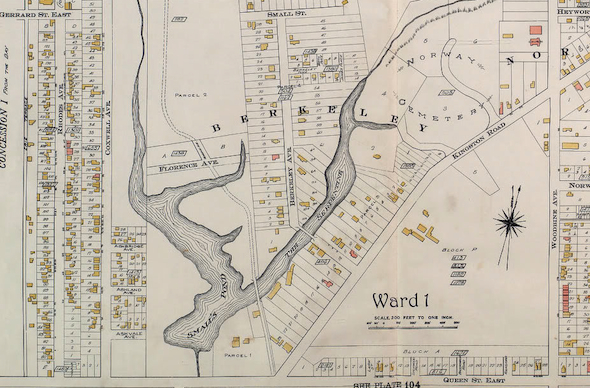 ASHBRIDGE'S CREEK
ASHBRIDGE'S CREEK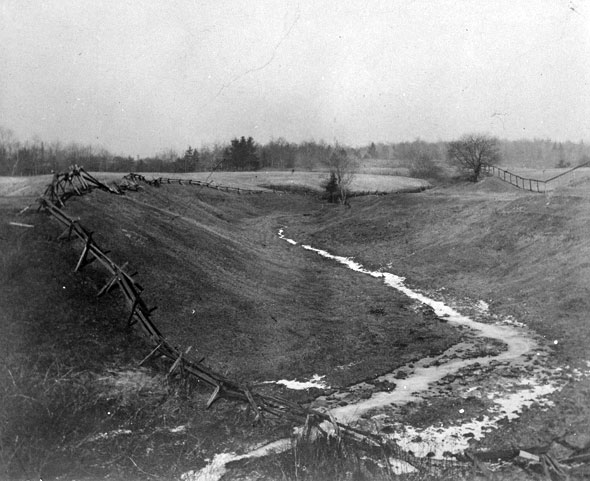 Ashbridge's
Creek was so un-loved that it appears never to have been given an
official name, though its geography is still easy to trace. Rising in two branches near today's Monarch Park,
"the creek," as early landowners the Ashbridge family called it, passed
under the rail tracks and down Woodfield Road, where it's still audible
in the sewers.
Ashbridge's
Creek was so un-loved that it appears never to have been given an
official name, though its geography is still easy to trace. Rising in two branches near today's Monarch Park,
"the creek," as early landowners the Ashbridge family called it, passed
under the rail tracks and down Woodfield Road, where it's still audible
in the sewers.At Gerrard, it moved slightly west, eroding a wide depression in the land where Highfield Road is now before draining into Lake Ontario at today's Eastern Avenue, just behind the streetcar yard. The lawn of the Ashbridge's home, which still stands on Queen Street E, got its dimpled texture from the river.
Today, Ashbridge's Creek flows into the Mid-Toronto Interceptor Sewer at Gerrard Street and ends life at the Ashbridges Bay Wastewater Treatment Plant.
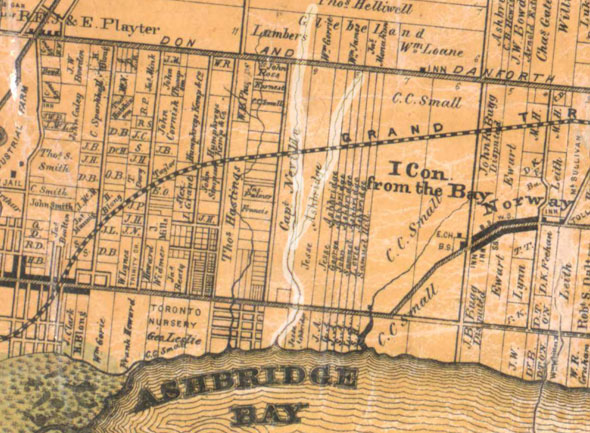 For more information on lost rivers, visit Lost Rivers, a great little resource for everything wet and buried in Toronto. Nathan Ng's map site is a great resource for discovering old streams.
For more information on lost rivers, visit Lost Rivers, a great little resource for everything wet and buried in Toronto. Nathan Ng's map site is a great resource for discovering old streams.Please share this
What Keele Street used to look like in Toronto
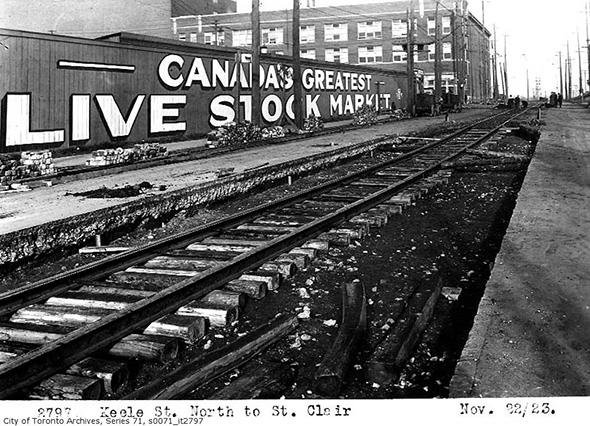 Keele
Street may not feel particularly central geographically in Toronto, but
historically speaking its been home to various hubs of activity for
over a century. From the Canada Packers Stockyards at St. Clair to High Park,
it's a diverse street with a rich history. Even today, the presence of
York University and the subway extension at its northern tip (at least
as far as Toronto goes -- the street actually extends to the Holland
Marsh), ensures that it remains a place where development chugs along.
Keele
Street may not feel particularly central geographically in Toronto, but
historically speaking its been home to various hubs of activity for
over a century. From the Canada Packers Stockyards at St. Clair to High Park,
it's a diverse street with a rich history. Even today, the presence of
York University and the subway extension at its northern tip (at least
as far as Toronto goes -- the street actually extends to the Holland
Marsh), ensures that it remains a place where development chugs along.In the past, the busiest section of Keele was located along the stretch between Dundas and St. Clair, which was home to a variety of industrial and manufacturing enterprises as well as the previously mention Stockyards. Photos from the early 20th century show a dense strip of road in the area, which was well served the by the junction of multiple railway lines that gave the neighbourhood its name (prior to be being called the Junction, the neighbourhood was referred to as West Toronto).
In conjunction with the presence of High Park (which opened in 1876), the absence of these rail lines around Bloor explains why development was slower to catch on around this section of Keele, which up to the early 1910s served as a city dump. To this day, the area south of Annette all the way down to the Lake Shore is primarily residential.
To the north of Eglinton, Keele is marked by the strip-mall aesthetic that one sees beginning to form in the last two photos below in 1959. While there's really no doubt that long stretches of Keele would fairly be described as unremarkable, when you get out and explore, it's easy to spot traces of the street's history in what seem to be banal places, and there's something rather rewarding about that.
PHOTOS
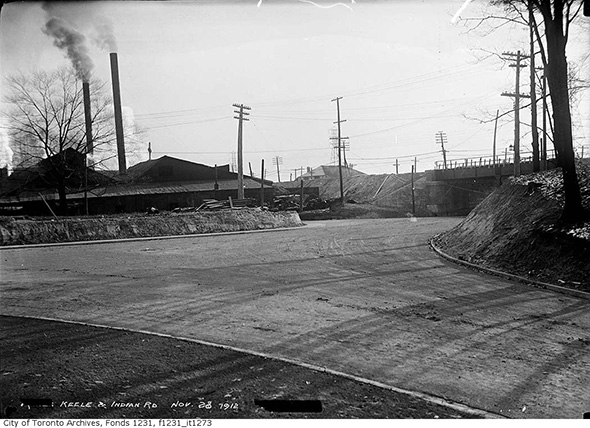 Keele & Indian Road, 1912
Keele & Indian Road, 1912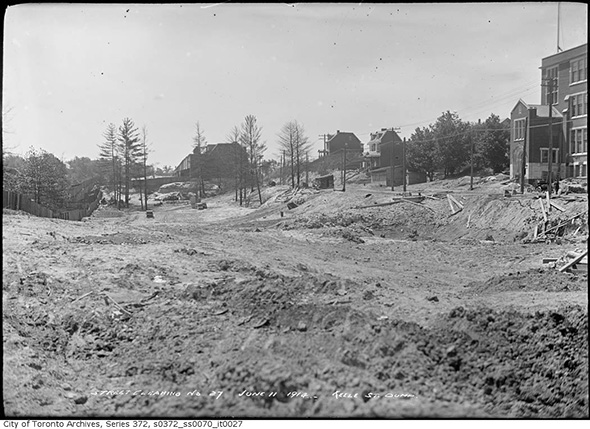 Remains of Keele Street Dump (at Bloor), 1914
Remains of Keele Street Dump (at Bloor), 1914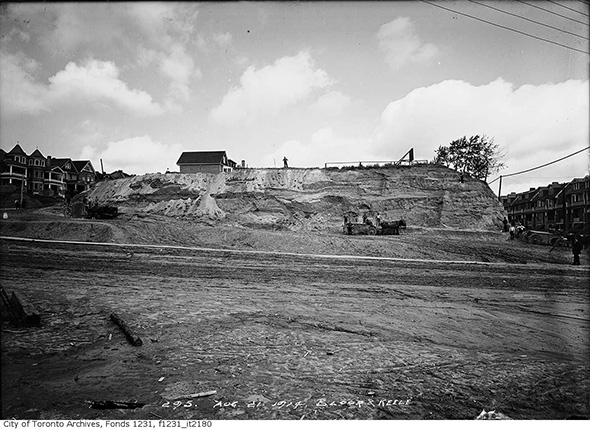 Bloor & Keele, alternate angle (also 1914)
Bloor & Keele, alternate angle (also 1914)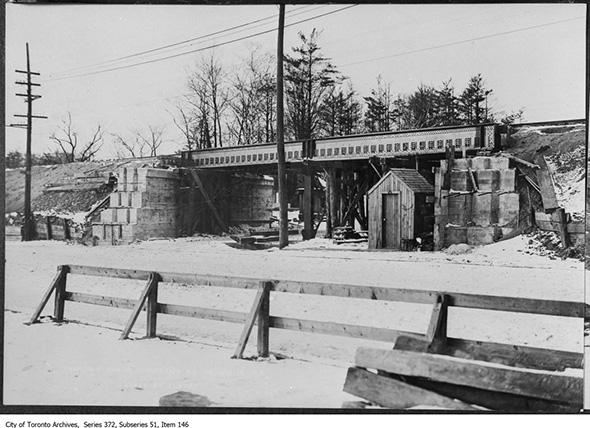 Keele Street Subway at Lakeshore, 1915 (now Parkside Drive)
Keele Street Subway at Lakeshore, 1915 (now Parkside Drive)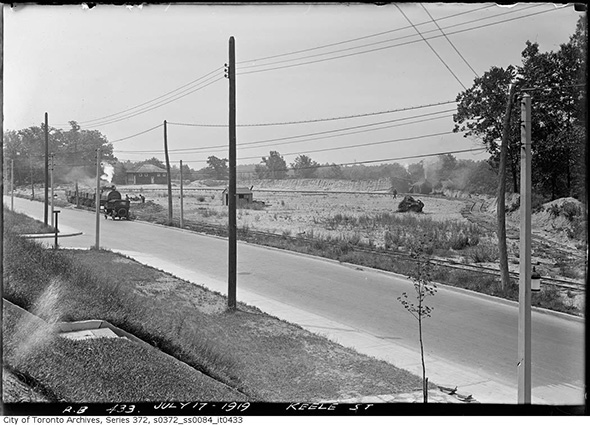 Keele Street, 1919 (unidentified location)
Keele Street, 1919 (unidentified location)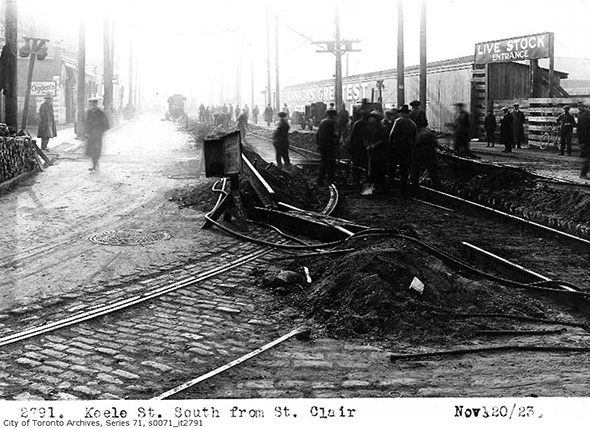 Keele looking south from St. Clair, 1923
Keele looking south from St. Clair, 1923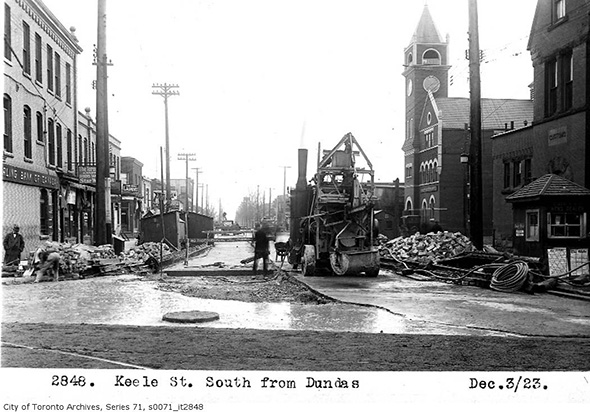 Keele south of Dundas, 1923
Keele south of Dundas, 1923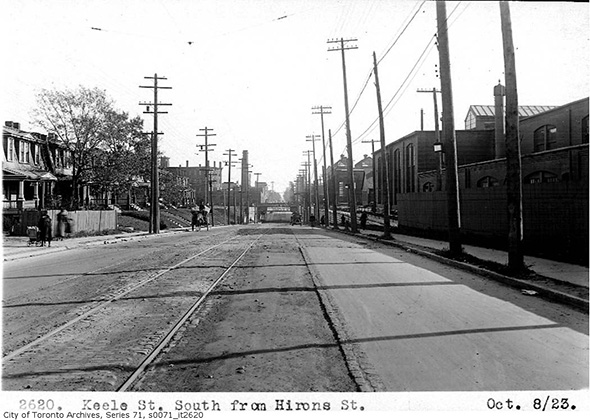 Keele south of Hirons, 1923
Keele south of Hirons, 1923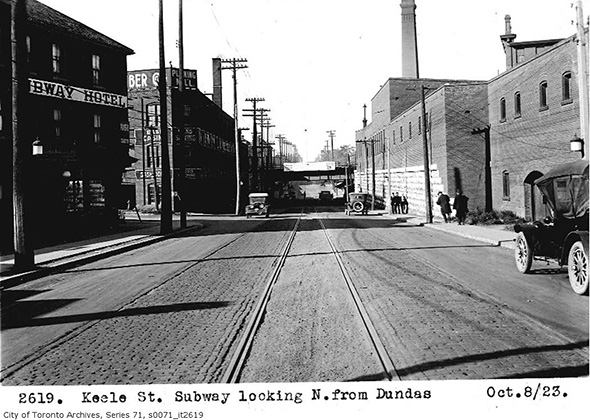 Keele looking north of Dundas, 1923
Keele looking north of Dundas, 1923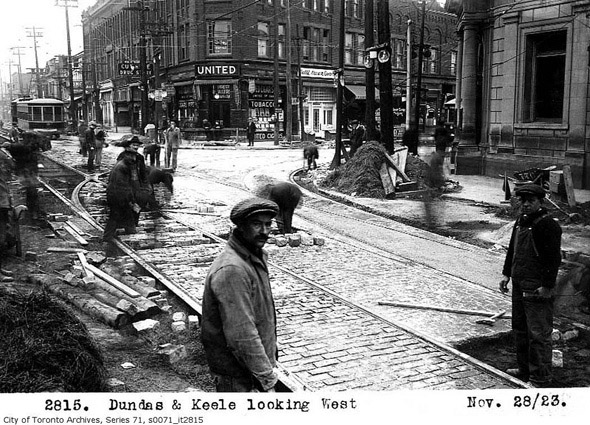 Dundas & Keele, 1923
Dundas & Keele, 1923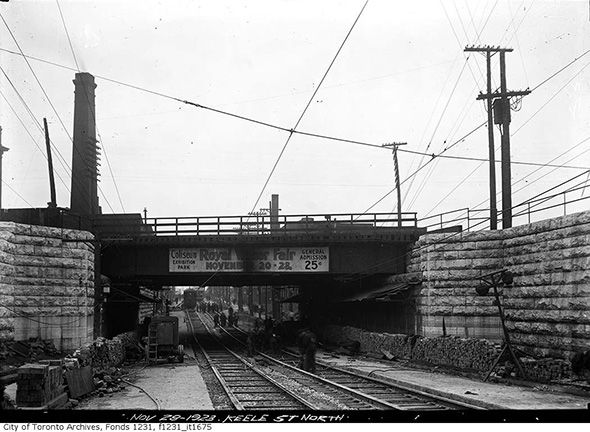 Keele Subway at Junction Rd., 1923
Keele Subway at Junction Rd., 1923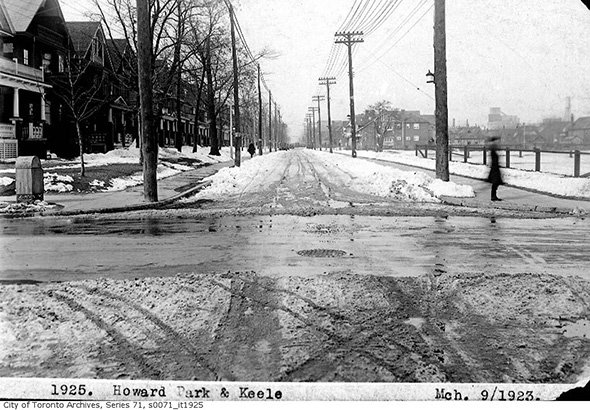 Howard Park & Keele, 1923
Howard Park & Keele, 1923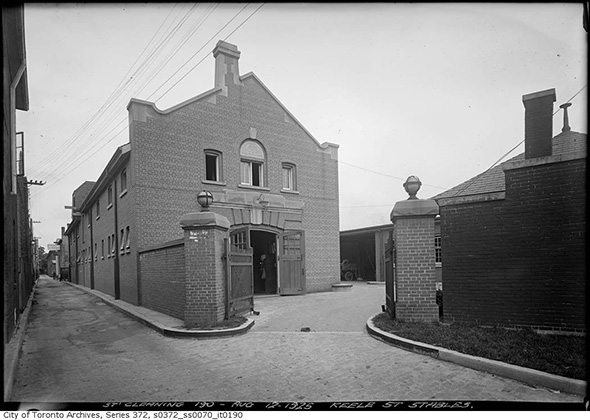 Keele Street Stables, 1925
Keele Street Stables, 1925 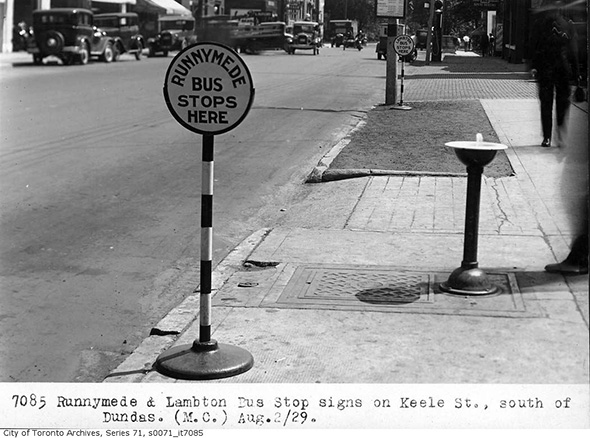 Runnymede bus stop, 1929
Runnymede bus stop, 1929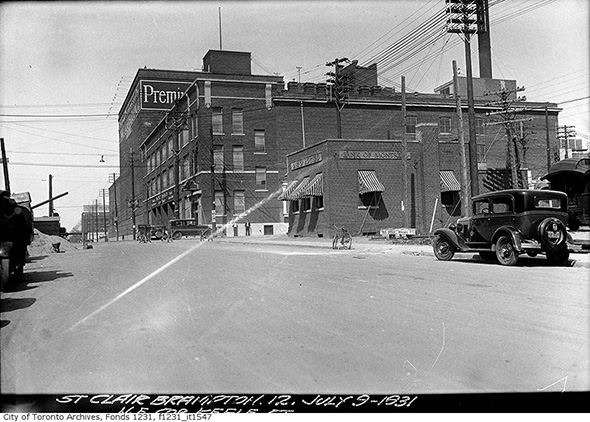 Northeast corner St. Clair & Keele, 1931
Northeast corner St. Clair & Keele, 1931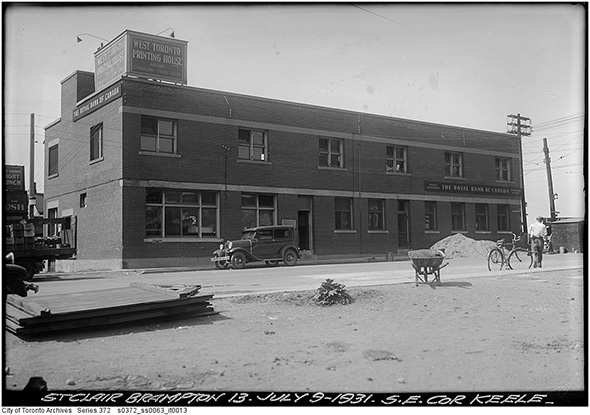 Southeast corner St. Clair & Keele, 1931
Southeast corner St. Clair & Keele, 1931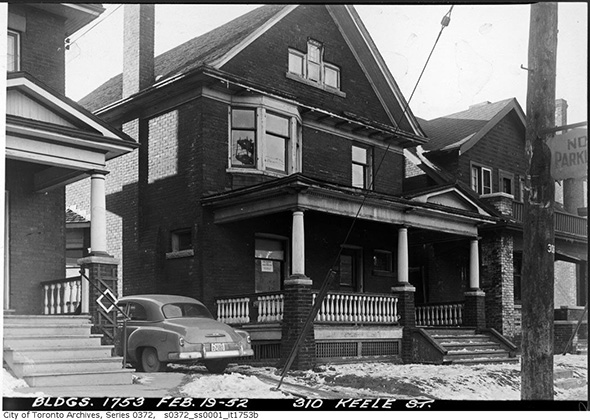 310 Keele St., 1952
310 Keele St., 1952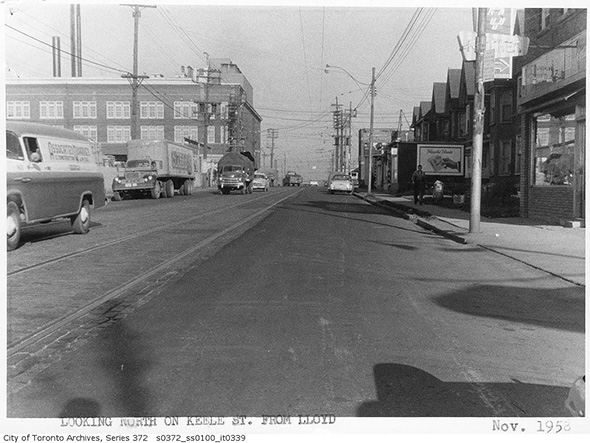 Keele looking north from Lloyd, 1958
Keele looking north from Lloyd, 1958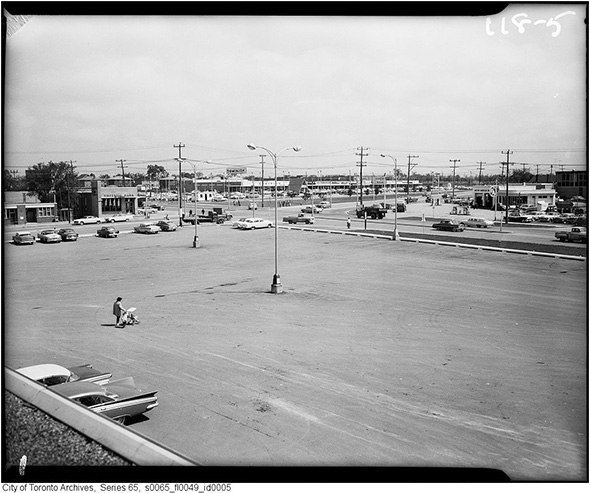 Keele & Wilson area, 1959
Keele & Wilson area, 1959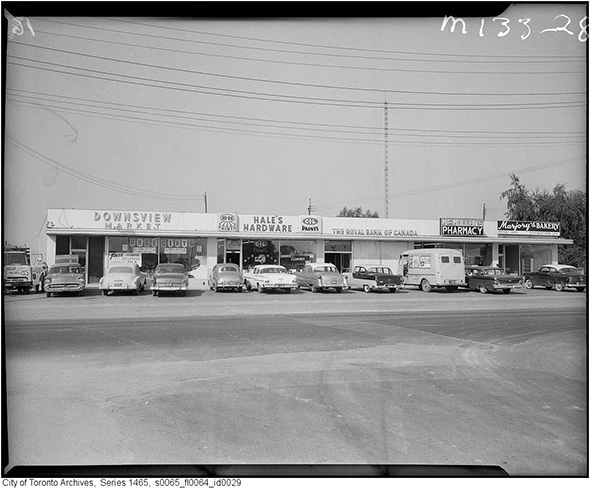 Downsview Market (Keele north of Wilson), 1959
Downsview Market (Keele north of Wilson), 1959Photos from the Toronto Archives
Subscribe to:
Posts (Atom)

